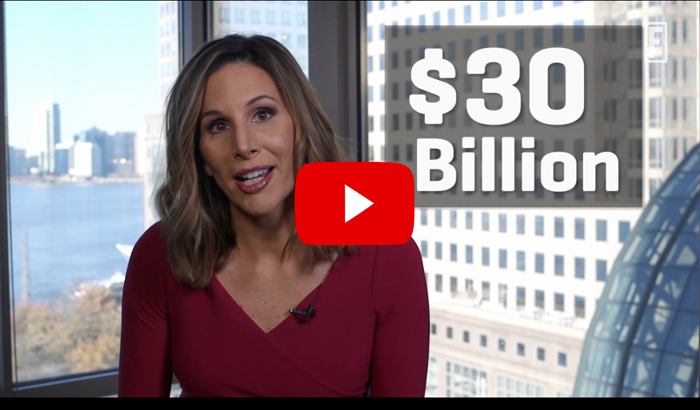6 Brand Culture Do’s and Don’ts for Attracting and Retaining Your Ideal Customers and Top Talent
/0 Comments/in Brand Culture /by Lorraine CarterRedefining Your Brand Culture After a Rebrand, Sale or Merger
/0 Comments/in Brand Culture /by Lorraine CarterWhen you think about a positive brand culture, what comes to mind? You might envision some of its tangible manifestations, like bean bag chairs or Friday happy hours. While admittedly fun, these examples unfortunately only scratch the surface of what brand culture means.
A truly positive brand culture goes beyond words on paper and frivolous office perks. It’s about being clear on your brand purpose and setting strong, clearly articulated brand values and living them out as a company, both internally and externally, every day. When implemented effectively, a strong brand culture breeds a positive public image and better retention rates, not to mention revenue growth [1].
Brand Culture is what every person in your organisation believes, does and lives to express your brand. It’s your collective way of doing things to express and reflect your brand’s purpose, vision, mission, values, promise, story and brand personality.
Brand culture, however, is a notoriously elusive concept, and one that becomes even trickier to master in the wake of a sale, merger or rebrand. In the case of a merger or acquisition, you’re faced with not just one, but two unique brand cultures that must be merged in a strategic and authentic way. And in the case of a rebrand, you must reconcile the old with the new. If your company has recently undergone any one of these major changes, it’s time to take a magnifying glass to your brand culture and take steps to redefine it.
Why Redefining Brand Culture Matters
If a rebrand, sale or merger has recently taken place within your company, you’re no stranger to change. From a re-evaluated, newly profiled and codified brand to an updated brand identity to a new employee handbook, you’ve probably already signed off on your fair share of updates to your brand. With so much in flux, it might be tempting to push aside defining your brand culture as a non-essential, or worse, as unnecessary. Brand culture, though, must not be left to chance or viewed as an afterthought. It impacts every part of the business, from employee satisfaction to productivity and profits.
Related: The Impact of Company Brand Culture On Driving Performance and Increasing Sales
For starters, a strong brand culture has a direct impact on your ability to retain top talent. According to a Columbia University study [2], the average likelihood of employee turnover at an organization with great company brand culture is 13.9%, whereas the likelihood of turnover in poor company cultures is more than triple that, at 48.4% so strong brand culture is a major competitive advantage.
Not only does a positive brand culture motivate employees to stick around, it also prompts them to get more done because it cultivates a strong sense of purpose, something bigger than the individual, all of which enhances job satisfaction. Happy workers are 12% more productive than the average worker, while unhappy workers are 10% less productive [3].
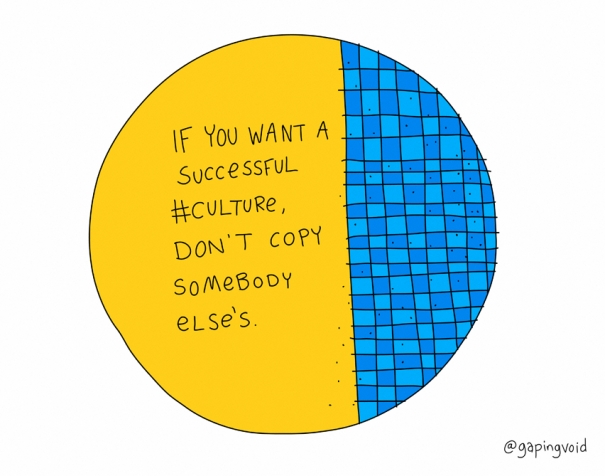
Image via ©Hugh MacLeod, Gapingvoid
Finally, and perhaps most importantly, a strong brand culture results in engaged workers, which are unilaterally linked with greater profits. Organizations with employees that are consistently engaged produce 10% higher customer satisfaction ratings and 20% higher sales, on average, than those with employees who are not regularly engaged with their work [4].
You can’t identify and define your brand culture without first codifying and mapping out your brand. If you need a hand with this crucial task, feel free to get in touch. We’ll develop the communications system for you that provides structure and guidance for all points of contact within a business, both internally and externally with your customer. Discover more about our brand strategy solutions here. We’ll also provide you with an action plan for successfully putting your brand to work internally and externally and direction with implementation too.
Because your brand strategy is the bedrock foundation underpinning your whole business it provides you with your road map for achieving specific brand goals aligned with your business plan. Discover more about our brand strategy service here.
Or if you’re simply feeling a tad overwhelmed by the ever-increasing market demands of a rebrand, sale or merger then get in touch because we have the perfect solution for you — three different ways of working with us to build your brand, depending on your preferences. So if you want us to:
- Build your brand for you – find out more here
- Empower you to build your brand – check out the Persona Brand Building Blueprint™ Mastermind here where you work on your brand with us
- Want a DIY solution? Check out our how to build a brand eprogramme here
You can also work with us to develop your brand strategy and brand culture through one of our Transformational Workshops, Masterclasses, Mentoring and Training. When you work with us on your brand in the Persona Brand Building Blueprint™ Mastermind you’re empowered to build and leverage your standout №1 brand. In fact, after two days of working with us on your brand you leave with your brand strategy fully developed, documented and ready for implementation in the business.
Four Key Areas to Re-evaluate in Your Brand Culture
When redefining your brand culture after a rebrand, sale or merger, it’s important to consider four key areas:
- Your Values
- Your Leadership
- Your People
- Your Customers
1. Your Values
Gradifi is a startup that gives employers an easy way to offer student loan repayment as a perk to their employees. In 2016, the company (which, at the time, was made up of less than 30 employees) was acquired by financial giant First Republic bank [5]. First Republic is a multi-billion-dollar company with more than 60 offices across the United States.
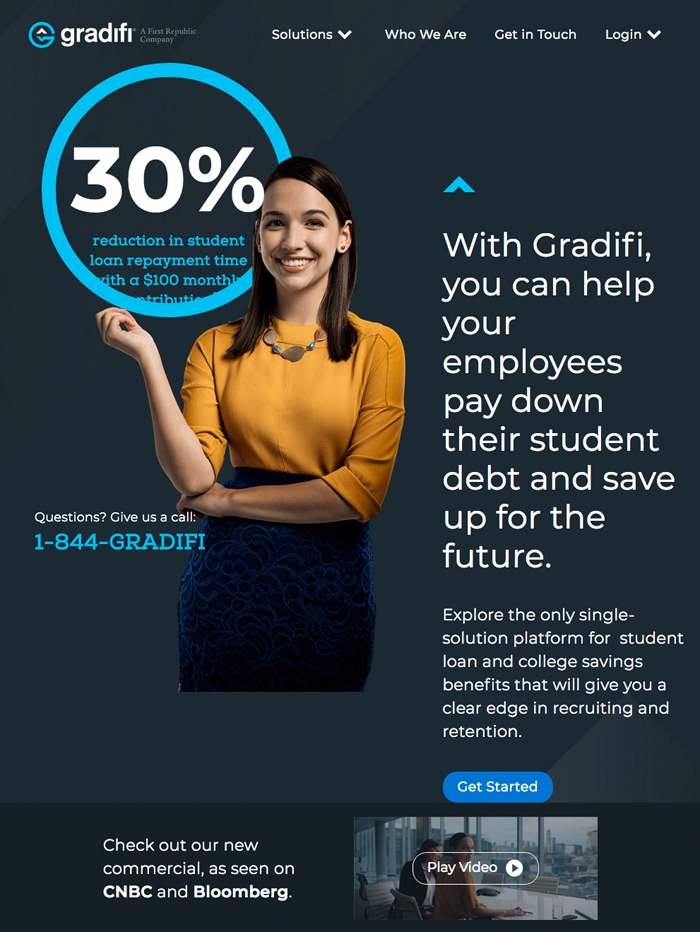
Image via Gradifi
The acquisition could have easily cost Gradifi its values, getting swept up and swallowed whole by the culture of its new parent company. Instead, the startup doubled down on its brand mission to do its part in making a dent in America’s ever-growing student debt crisis. Gradifi enlisted the support–both in branding and financial resources–from its new parent company to bolster its core values. As a result, it was able to offer its customers more financial stability via First Republic’s $68 billion portfolio of assets [6].
Gradifi is a perfect case study in using a merger or acquisition to strengthen rather than dilute your brand culture. After a sale or merger, find ways in which your new partner can support your brand values in a way that complements your existing efforts, or in new ways that you may not have been able to execute on your own.
2. Your Leadership
Independently, Hackensack University Health Network and Meridian Health were two of the largest hospital systems in their state. When the two merged in 2016, it was under the leadership of two strong personalities: Hackensack’s Robert C. Garrett and Meridian’s John Lloyd.

Co-Chairs: Robert C. Garrett and John Lloyd
It was a time of uncertainty for the healthcare industry as mergers advanced at a faster clip than ever before. In an effort to streamline the transition and position the new, combined brand for success, the organizations made an unusual decision. Rather than transitioning leadership to a new CEO, the companies opted to keep both Garrett and Lloyd in place to serve as co-chairs.
Though unorthodox, if we turn our attention to the impact of leadership on brand culture, the decision comes as no surprise. Hackensack Meridian’s new leadership structure works–very well, at that–because both leaders shared a clear, common brand vision that they’ve defined as the “continuum of care.”
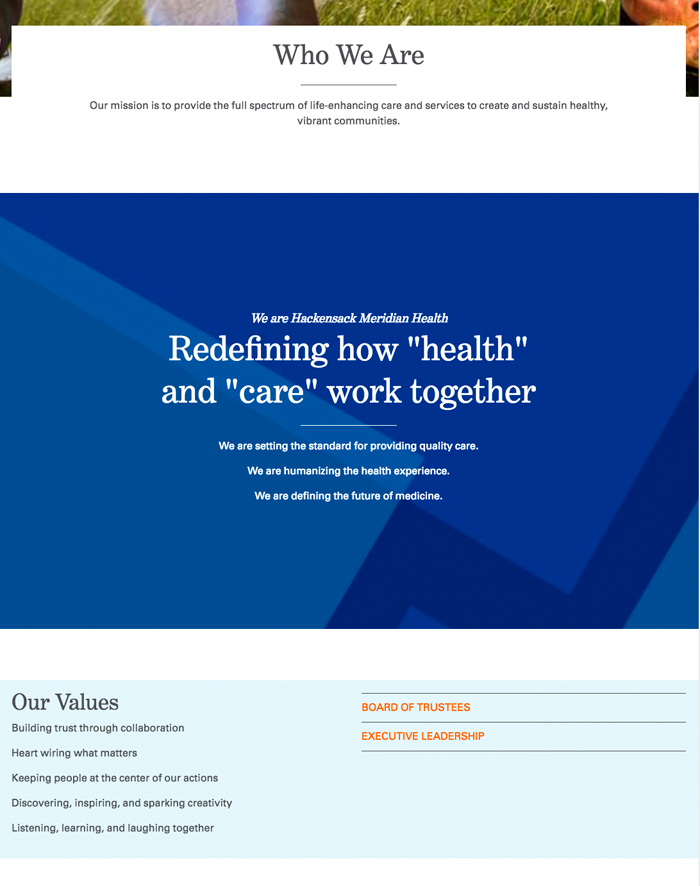
Image via Hackensack Meridian Health
According to the co-CEOs, this means care doesn’t end when the patient leaves the hospital, but extends into the community and its programmes [7]. The brand has codified this vision into every element of its business model. The new hospital network is ranked number one in New Jersey and consistently wins top honors in nationwide rankings.
Related: CEO Brand Leadership, How Vision Drives Brand Growth
No matter what your new leadership structure after a merger or acquisition, brand culture directives must come from the top and not the other way around. To ensure brand culture success, your leader must actively take charge in defining and executing on it in a way that fits within and supports your brand strategy.
A memorable, profitable brand starts with a solid strategy. The Persona Brand Building Blueprint™ Mastermind empowers you develop yours with our support and leadership! In this highly interactive, two-day live mastermind, you map out, codify and document your brand and leave with a clearly defined brand strategy to underpin and guide all of your business objectives. Reserve your place in our next Brand Building Mastermind now.
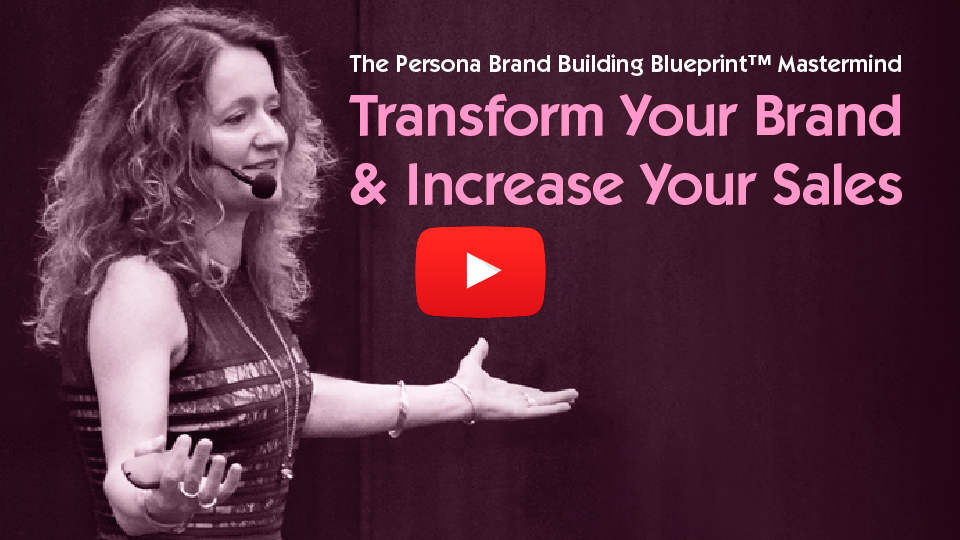
Build your standout brand at the Persona Brand Building Blueprint™ Mastermind with Lorraine Carter
3. Your People
When drugstore chain Walgreens rebranded in 2017, the move was much deeper than just a new tagline and service offerings (as all rebrands should be). The company introduced a revamped brand culture with employees at the centre [8]. At every turn, the brand culture is informed by an iron-clad brand promise: “We’re here to help everyone – every day. Beyond a new tagline, we hope to reflect where our brand is headed in the future with new initiatives and services that align to our brand promise: to always to be here to help you feel good.”[9]
Watch one of the installments from Walgreens’ rebranding video campaign, which is underpinned by a culture where employees are on the front lines to execute the brand promise:
In a rebrand, you’re likely doing some heavy lifting on visual elements like your brand packaging, brand identity and brand collateral, but don’t leave employees out of the equation because they are the most critical factor in your success. Think through not only the relationship your team will have with the updated brand, but the relationship they’ll with have with your customers. Both are core elements of your brand culture.
Related: Maximizing Profitability, Training Your Employees To Be Brand Champions
4. Your Customers
Starwood Hotels and Marriott are two major forces in the hospitality industry, both heavyweights in their own right. When Marriott acquired Starwood in 2016, though, some worried the marriage was a mismatch [10]. Marriott, on one hand, was the traditional mainstay, with a nearly century-long history of dependable, albeit somewhat vanilla, accommodations. Starwood, on the other hand, was the cool, quirky younger brother, known less for legacy and more for hotel rooms that feel like crashing at a friend’s place.
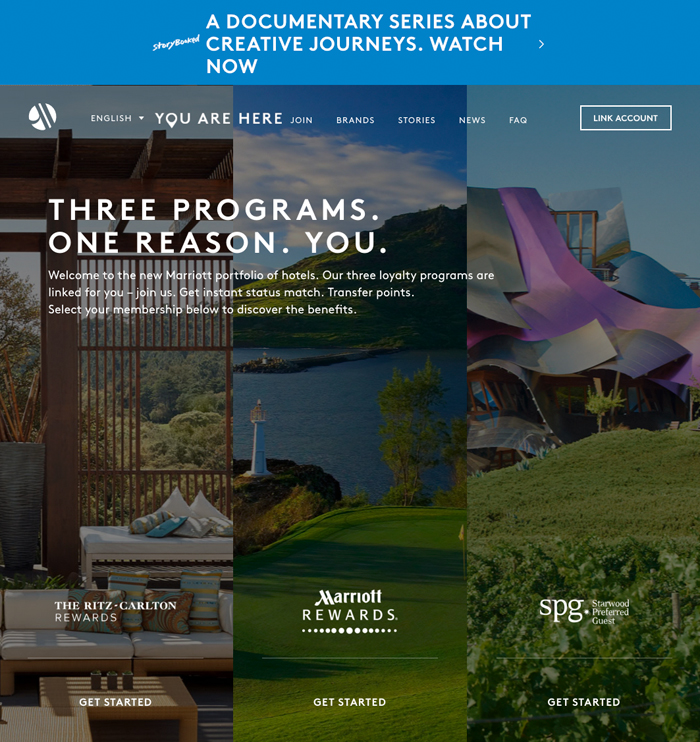
Image via Marriott International
To avoid chaos when the brands combined cultures, they focused on the one thing they have in common — fiercely loyal customers — birthing a new brand culture with customers at its core. In a rare move, the brands opted to allow members of either chain’s loyalty programme to enjoy the benefits of both–including tiered pricing on luxury rooms, which meant more choice and in some cases, much nicer rooms at cheaper rates [11].
Under Marriott’s ownership, the brands have launched a storytelling series spotlighting reward members during their unique travels, further enforcing the customer-centered culture. Marriott and Starwood’s customer-centric approach proves that a merger can be a positive thing for brand culture, so long as the two companies find and focus on their common ground.
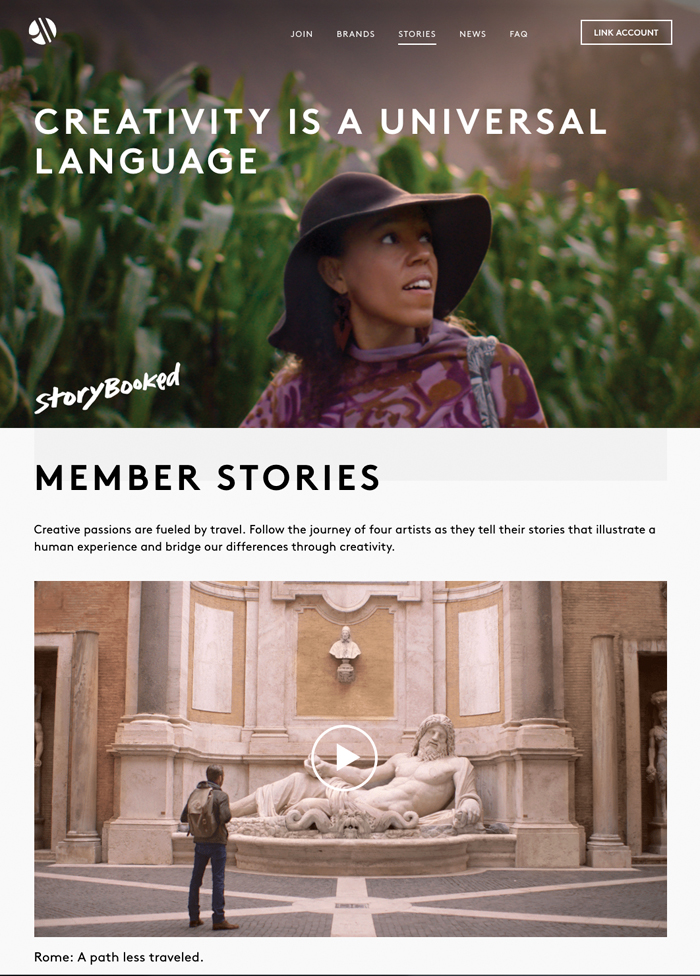
Image via Marriott International
Your customers are the final piece of the puzzle after a merger, sale or rebrand. How will the change affect their relationship with your company? Define a brand culture that supports the relationship you want to have with your target market, which should be part of your overall brand strategy.
Related: Company Culture, Your Brand’s Strongest Competitive Advantage
Your brand culture is the summation of what your brand stands for: how you live out your brand purpose, brand personality, brand mission and brand promise in your daily operations. Brand culture isn’t something that “just happens”; it must be carefully considered and codified in keeping with your brand strategy like any other aspect of your business to ensure success after a merger, sale or rebrand.
Don’t leave your brand’s reputation to chance! Take charge in building a memorable, much-loved and highly profitable brand with Brand Strategy Development from Persona Design. We’ll lead the way in this vital branding process and deliver you a complete, easily understood and executable brand strategy that underpins and drives your business goals. We’ll also support you through the implementation process too.
Contact us directly at T: +353 1 8322724 or [email protected] to get started.
Questions To Consider:
- How strong is your brand culture? What are its strengths and weaknesses?
- What are your core brand values? How have they been impacted by your sale, merger or rebrand?
- What is your new leadership structure? How will the leader lead the way in defining and living your brand culture?
- What relationship do your employees have with your brand? What role will they play in executing your brand culture?
- What relationship do you want customers to have with your brand? In what ways does your brand culture support this relationship?
Sources
- https://www.forbes.com/sites/larryalton/2017/02/17/why-corporate-culture-is-becoming-even-more-important/#4771edf969da
- https://academiccommons.columbia.edu/catalog/ac:156625
- https://warwick.ac.uk/newsandevents/pressreleases/new_study_shows/
- http://news.gallup.com/businessjournal/208487/right-culture-not-employee-happiness.aspx
- http://www.sfchronicle.com/business/networth/article/Why-First-Republic-bought-student-loan-repayment-10791909.php
- https://www.firstrepublic.com/frb/shared/repositories/newsroom-folder/2016/12/12/first-republic-bank-acquires-gradifi
- https://www.app.com/story/money/business/main-street/2016/11/04/hackensack-meridian-health-two-ceos/92521496/
- https://www.cnbc.com/2017/12/04/walgreens-unveils-rebranding-effort-as-pharmacy-wars-escalate.html
- http://news.walgreens.com/press-releases/general-news/trusted-since-1901–walgreens-heritage-of-providing-care-helps-define-new-brand-identity-and-campaign.htm
- https://www.nytimes.com/2017/12/09/business/marriott-starwood-customer-loyalty-program.html
- https://www.entrepreneur.com/article/293987
4 Reasons Why Your Business Profit Starts With Your Brand Mission
/0 Comments/in Brand Culture, Brand Mission, Brand Profiling & Positioning, Brand Strategy, Branding /by Lorraine CarterIn just about any niche, competition is fierce. Yet many SME, SMB, mid-size to large companies neglect to develop and articulate their brand mission because they’re either not sure how to do it or don’t realise it’s importance.
This in effect means they have nothing of substance [beyond price fights] to attract their ideal customers, whether their audience is B2B or B2C. Your brand mission is one of the critical deciders in captivating your ideal customers so they don’t go to, or buy from your competitors.
When you’re clear on your company’s brand mission, it acts as the overall steering mechanism of the business.
The best companies in the world understand the value of brand mission. It is your brand mission that impacts key decision making, strategic planning, productivity, service and brand strategy and marketing direction.
The real secret of incorporating your brand mission though, is that it drives profit growth because your brand mission and everything that follows it is what attracts the right people – employees and customers; those who believe what you believe. And when you tap into what’s important to the right people, you make considerably more money.
Related: 6 Tips For Building Your Profit Growth Plan
What Does Brand Mission Mean?
Branding is all about human psychology and perception. It consists of different levels, like the brand vision which drives the other elements, including the mission. Brand mission answers the question of, “how do we achieve our brand vision?” It is the “who we are and what we do” of a company.
Let’s get one thing clear from the start though, your brand mission is not a dusty mission statement hanging on the corporate wall. Rather, it’s how the company carries out its mission.
The biggest benefits of developing a clear, strong brand mission are:
- Recognition. Even if your business slots into the small to medium sized, having consistent messaging, tone-of-voice, language, personality, look and feel makes it much easier to attract and remain front-of-mind in your ideal target customer.
- Professionalism. Branding your business makes you appear better, larger and more successful. It makes you more trustworthy, and trust is what makes people ultimately decide to buy.
- Purpose. The brand mission unites employees in one single purpose and makes the business stronger and more effective. When the employees of a company or organisation have a compelling purpose, a reason for being part of something bigger than themselves, then the drivers behind what they do are far more compelling and effective than mere economics alone. These emotional factors are far more potent because they’re the driver behind why people commit to buying something more expensive, working after hours when needed, going the extra mile and so forth. People need to feel that the work they do matters and is part of something bigger — a brand mission is the rallying call for this.
Related: The Age of Internal Branding and Selling From The Inside Out
In the video below, Simon Sinek talks about the psychology of employee fulfillment. A brand mission unites the humans in your company and gives them a sense of common purpose, which ultimately leads to higher productivity and superior quality work.
This is a vital point because much of the monetary benefits derived from a strong brand mission are the consequence of how employees respond when they share a greater sense of purpose.
What Makes A Strong Brand Mission?
A strong brand mission must;
- Be really clear
- Easy to understand
- Represent a higher truth
- Create a lasting impact in the world
- Have meaning beyond the money
Developing a brand mission is about pulling together your company’s vision, strategy, future product and service development, together with its operational and marketing priorities.
By using strategic thought, creativity, expression, and innovation, it combines:
- The company mission
- The customer mission
- The business mission
Essentially, your brand mission is your framework for action, your raison d’être behind the what, why and how for everything you do — the drivers for not only you and your internal team but for the reasons why your customers choose you over your competitors.
Related: Family Business Branding And The Secret Drivers to Brand Success
How Your Brand Mission Drives Profits
1. Brand Mission Underpins Your Company Performance
Raj Sisojdia, a Babson professor, studied 28 companies between 1996 and 2011. His conclusion was that purpose-driven enterprises grew by a whopping 1647% compared to the S&P 500 average of 157%.[1]
Many of the best companies in the world are a result of high employee engagement, which is based on purpose. And purpose, more than money, motivates people to arrive at work every day so that they can make a difference.
The very sad fact is that the majority of employees don’t even know the brand purpose of the companies they work for.[2]
Traveling Vineyard on the other hand, a direct wine sales small business, increased customer acquisition by clarifying their purpose and brand mission.[3]
They changed their focus from “wine sales” to “sharing the love of good wine with the world”.
Related: Personality Matters: Bringing Your Brand to Life to Grow Profits
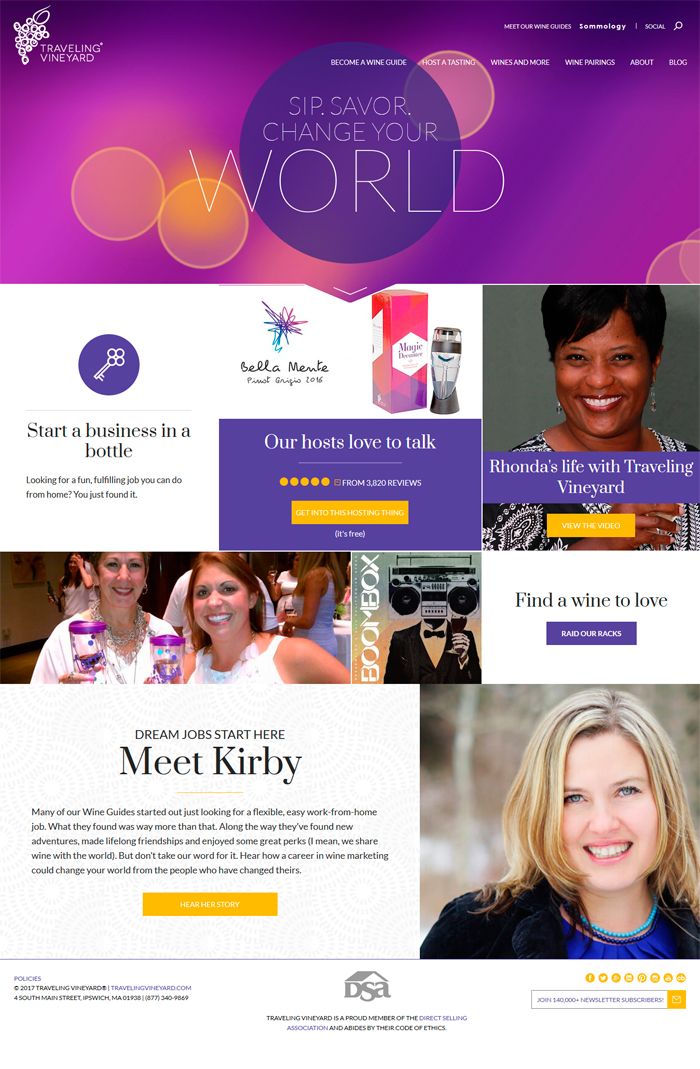
Image via Traveling Vineyard
The Traveling Vineyard lives out their brand mission in everything they do and is expressed through the language and messaging on their website. This critical change in focus in their brand mission is what delivered a dramatic increase in people becoming Wine Guides; resulting in an increase in wine sales.
Their revamped strategy became about getting people to become Wine Guides (ultimately sales reps) who share wine experiences in a relaxed home environment. Instead of focusing on getting people to sell their wines, they changed their internal culture to be one that would transform lives by providing fulfilling, fun and flexible work.
In this way, they were able to bring their customers and employees together with a more meaningful purpose. Changing their internal brand mission resulted in a 49% increase in conversion rates for Wine Guides in the first year, and 83% lead forms submission on web pages that expressed the company’s purpose.
Related: Brand Profiling: How Brand Performance and Purpose Are Inextricably Linked
2. Brand Mission Attracts The Right People
One of the greatest reasons for incorporating a brand mission, is that it helps attract the right people, for the right reasons. Who are the right people? Those that will ultimately buy from you. And of course, it’s essential to draw the right employees to your company; those that are the right “fit” for your company’s culture, and those who will add the most value to your vision.
Your brand mission aligns the internal (staff) and the external (customers).
The Airbnb Story: How Three Ordinary Guys Disrupted an Industry, Made Billions … and Created Plenty of Controversy, by Leigh Gallagher, tells of how a young brand developed into a household name because of its brand mission.
Essentially, Airbnb is a tourist booking facility, but what separates it from it’s competitors is that the focus is on making memories and creating experiences. It is this mission and message which has been and continues to be one of the key drivers behind their success.
In mid-2014, Airbnb developed a new mission — to make people around the world feel like they could “belong anywhere.”
The founders wanted Airbnb to stand for something much bigger than travel; it would stand for community and relationships and using technology for the purpose of bringing people together.
Related: The Impact of Company Brand Culture On Driving Performance and Increasing Sales
Check out the story[4] about Airbnb’s massive growth, and how their brand mission catapulted it:
Although now a household name in many parts of the world, Airbnb started as most businesses start – small. Now that they’re a well known brand name, you may be thinking their branding story may not be applicable to you.
Related: Brand Stories: 5 Compelling Examples That Sell Themselves
Even if you’re flying solo – you may be a freelance writer, business consultant, coach, author, IT consultant, or building a multi-level marketing business – you should still have a brand mission to differentiate yourself from your competitors.
Do a Google search with your niche keyword and you’ll see just how many online competitors you have, so you need to develop and use your brand mission as part of your strategy for standing out and getting attention from the people who need your service or product. As a solopreneur, it’s especially important to discover your uniqueness and leverage your personal brand identity. Otherwise, you’re just another anchovy fish lost in the ocean.
If you want direction and support empowering you to transform your brand so you stand out and increase your sales then the Persona Brand Building Blueprint™ Mastermind is the perfect fit for you.
This is a two-day brand building intensive shared with a small group of like-minded peers where you work on your brand with our leadership. In fact, over the two days, you re-evaluate your brand, codify it and create your brand strategy to stand out and attract your ideal customers from the ground up whether you’re revitalizing an existing brand or creating a new one.
This is not a theory based programme but a highly interactive fast-track course where you work intensively on your brand throughout the programme duration, under our tutelage, using our ten step system to:
- Completely re-evaluate your brand to make it much stronger so it’s highly visible enabling you to increase your profits
- Map out your brand in full so it’s codified and comprehensively documented to grow your business faster
- You leave with your total brand road map or GPS of your brand empowering you to manage your brand, stand out and attract your ideal customers so you multiply your sales
Outcome: Your brand transformed so you increase your sales.
At the end of the two-day Persona Brand Building Blueprint™ Mastermind, you leave with your fully documented brand strategy ready for implementation in your business or organisation.
If your team is larger and you’d like to include everyones’ participation in the Persona Brand Building Blueprint™ Mastermind then we also run in-house private client brand building intensives tailored to your bespoke requirements so you’re empowered to take your business further a lot faster.
Ring us today and discover how to build your winning brand to make it really stand out and increase your sales
Want to know more? Give us a ring T: +353 1 8322724 (GMT hours 9:00 – 17:00) to discuss your preferences or send us an email to [email protected]
Regardless of the size of your business, you need to know who you are, what you stand for and what you can offer your audience because the service or products you promote are not what you are really selling.
Remember, 60% of branding is about perception and only 40% is about your product or service so you must touch the heart first if you want to move the mind.
Once you understand that and begin marketing with that concept front of mind, that’s when you’ll really start generating serious revenue.
Just like a brand mission for conglomerates, a personal brand is a combination of your strengths, passions, gifts, and the purpose that you bring. In the next video by TEDx Talks, Anand Pillai provides a formula for building a personal brand, remembering that your mission is what drives your business, solo or major conglomerate:
Related: Personal Branding: We Are All CEOs (Part 1)
Smaller B2B companies can stand out from the crowd simply by providing brilliant content on their website, as the Buffer App does on their blog. A simple branding strategy for smaller businesses, Buffer is creating a cult following by publishing content that is irresistible and central to their brand mission.
Buffer’s brand mission[5] is to “create helpful, actionable content that helps people with their social media presence. To connect a community of like-minded people with passions for social media, self-improvement, and Buffer’s values. To share Buffer’s internal approach, philosophies, and culture to help create a new way to work”.
Their mission drives their brand strategy and consequently all marketing activities.
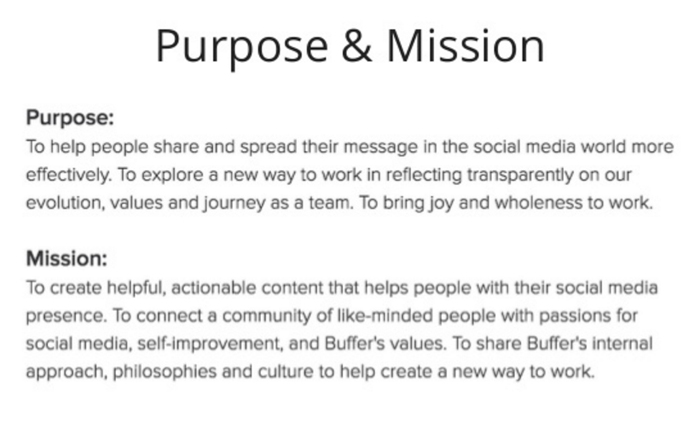
Image via Buffer Slideshare
Buffer was only founded in 2010. In 2016, their staff complement doubled from the previous year. They now boast 75 employees who work remotely around the world.
Their success is further evidenced by the results achieved with their content: one of their posts[6] has been shared 23 000[7] times and earned 210 000 likes on Facebook. Not bad for a humble team of 75…
By addressing target audience problems via blogging, and becoming known for publishing genuine value-add content, they get the attention of the people they’re targeting.
Related: Personal Branding: We Are All CEOs (Part 2)
3. Brand Mission Creates Consistency
Have you ever experienced exceptional service from a company, and the next time, expecting the same level of service, were deeply disappointed?
That’s because the brand lacks consistency. In fact, consistency engenders trust so if your brand falls short in any areas of the business or at any brand touch point, be it your brand collateral, customer facing staff, service or product delivery you undermine the power of your brand. Consequently, your sales and profitability are also immediately compromised because inconsistencies plant seeds of doubt and create bad customer experiences. Companies who boast consistent good customer experience are those who put standards in place to carry out their brand mission consistently in everything they do.
Brand awareness also depends on consistency. In fact, every aspect of managing, protecting, directing and preventing unintentional brand sabotage requires branding style guides.
Related: Brand CSR: The Business Case for Successful Branding and Social Good
If you want direction developing your brand so you can increase your profits then take a look at our online brand building eprogramme called the Personality Profile Performer™. This online course takes you through all the key steps you need to implement as you build your brand, including your brand mission. You can watch a free course preview here.

Build Your Brand Mission Using The Personality Profile Performer™ Programme with Lorraine Carter Here
If you’d like professional direction to develop your brand mission and would like to explore working with us then send us an email to [email protected] or give us a ring T: +353 1 8322724 (GMT hour 9:00 – 17:00). We’d be delighted to talk with you.
4. Brand Mission Ensures Clarity
Companies who provide the best customer service experience are driven by employees who are armed with clarity because their brand mission enables effective and fast decision making with clear judgment. Consider the front facing staff member who is shouted at by a disgruntled customer. After calming the customer down and finding out the exact issue, the employee is able to rectify the issue by taking some kind of on the spot action.
In the same way, leaders who have a clear sense of what matters most, are enabled to set priorities and determine the best path for the organization. Clarity drives commitment and dedication.
Related: CEO Brand Leadership: How Vision Drives Brand Growth
Summary
The best companies in the world to work for, and the most profitable, understand the power of the brand mission.
Developing your brand mission drives the company vision. The key benefits are brand awareness, effective lead generation, professionalism, and most importantly, providing a united purpose between employees which in turn generates multiple other benefits that collectively impact the bottom line positively to increase sales.
Related: What’s a Cult Lifestyle Brand And How Do You Create One?
Essentially, your brand mission is the driving mechanism that activates success.
In summary, your brand mission drives profits by:
- Boosting employee performance and company growth
- Attracting the attention of your ideal target audience
- Creating consistency in brand messages and service which builds trust
- Providing clarity for leaders and employees
Questions to consider…
- How does your business achieve its overall vision?
- What need does your business hope to fulfill?
- Does each member of your team understand his or her role in your overall brand vision?
- What separates you from your competitors?
- How do you touch the hearts of your customers so buying decisions are no longer about selling at the lowest price?
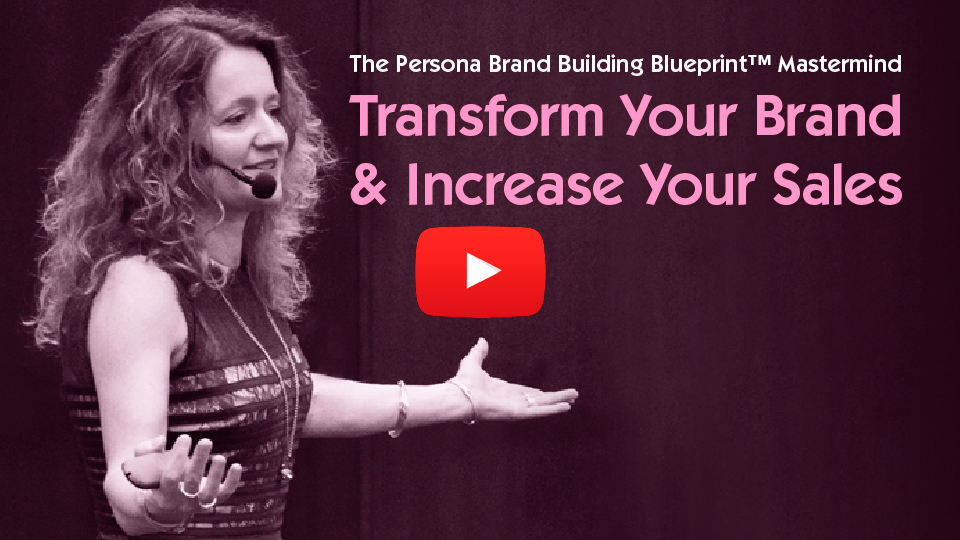
Build your brand strategy at the Persona Brand Building Blueprint™ Mastermind with Lorraine Carter
[1] https://www.brandingstrategyinsider.com/2016/12/how-brand-purpose-propels-brand-profits.html#.WTab1dwlHIU
[2] https://innovatenewalbany.org/branding/why-purpose-driven-companies-are-beating-the-competition/
[3] http://genuinely.co/what-we-do/case-study/
[4] http://fortune.com/airbnb-travel-mission-brand/
[5] https://www.slideshare.net/Bufferapp/buffer-marketing-culture/2-Purpose_Mission
[6] https://blog.bufferapp.com/10-scientifically-proven-ways-to-make-yourself-happier
[7] https://insights.newscred.com/branded-content-marketing-hubs/
The Age Of Internal Branding And Selling It From The Inside Out
/0 Comments/in Brand Ambassador, Brand Champions, Brand Culture, Brand Experience, Brand Leadership, Brand Strategy, Brand Values, Branding, Internal Branding /by Lorraine CarterDid you know that internal branding is the best way to get employees to develop a powerful emotional connection to your products or services so they become your top performing brand advocates because effective internal branding increases sales?
That emotional connection with the brand and its culture is what drives more than 2 million[1] people annually to apply to Google for a job.
Google is an unparalleled example of a brand which cultivates cult-like desire to work for them because candidates know that while Google only selects the creme-de-la-creme, the most elite top performers, the company also values their staff as their most important asset and looks after them accordingly. In short, Google understands the power of internal branding strategy, and selling the company from the inside out.
When staff are emotionally vested in the brand, they’re more loyal, motivated, productive, innovative, fulfilled and inspired by a unified sense of purpose.
Related: What’s a Cult Lifestyle Brand, and How do You Create One?
By applying branding principles from the inside first, employees glean a fuller knowledge of the brand and what’s important to it. Employees begin to “live” the vision of the company in their day-to-day tasks. And when employees live that vision in their roles the brand comes alive so your customers experience your brand’s promises to the full.
Related: Top 10 Brands for Customer Experience and What You Can Learn From Them
This article shares with you how to sell your brand from the inside out. But first, to make it more relatable so the theory is transformed into practical application take a look at this video which talks about the concept of internal branding.
The Link Between Employees and Internal Branding
Think about it for a moment, 60% of branding is about perception and only 40% about your product or service so one of the most significant factors influencing customers choices is how they perceive, think and feel about your brand through their interactions with it.
Contrary to what many think, branding is not just a logo or the aesthetics of a company’s website. Branding is the core DNA of your company – what makes it tick, the driving purpose behind everything you do and how you express your stand out brand personality at every touchpoint to engage your customers emotionally.
Because it’s only when you touch the heart that you move the mind so transforming your customers into committed fans, enthusiastic referral partners, word-of-mouth advertisers and repeat purchasers.
Anthony Robbins explains how emotions influence and drive all purchasing decisions masterfully here.
Related: Personality Matters: Bringing Your Brand to Life to Grow Profits
If you want some direction developing your brand and your internal branding then take a look at our brand building programme called the Personality Profile Performer™. This online course takes you through all the key steps you need to implement in building your brand. You can watch a free course preview here.

Build Your Profitable Brand Using The Personality Profile Performer™ Programme with Lorraine Carter
Alternatively, if you want in-person professional direction with expert input to develop your brand and internal branding and would like to discuss working with us then give us a call T: +353 1 8322724 (GMT hours 9:00-17:00) or drop us a line to [email protected]. We’d be delighted to talk with you.
Employees Are Your Internal Brand
The 2016 Edelman Trust Barometer confirms that people trust what employees say about the company more than they trust what the company says about itself. Trust is central to every brand because, without it, people will not buy from you.
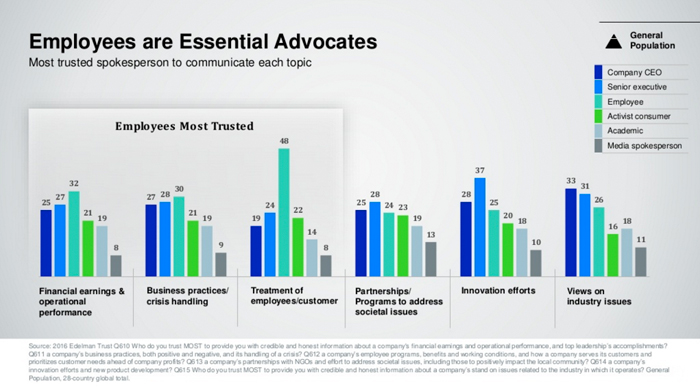
Image via Edelman Insights
When do employees represent, express, becoming living evidence of and talk about your brand? Front-facing staff represent your brand through their interactions with your customers. Non-front facing staff represent your brand when they discuss your company with friends and family and chat about their day on social media. Employees chat amongst themselves about your company — the good, bad and ugly.
Consider this, most of your employees are on social media and are either phenomenal ambassadors for your brand, indifferent workers clocking in time or worse still major detractors undermining your brand reputation.
Related: Top 10 Tips For Managing Your Brand Reputation
The ripple effect and network of influence per employee is extraordinary. It’s up to you to harness this for the greater good with strong internal branding or, through negligence, be at the mercy of come what may. At the very least make brand induction and training integral to what you do so you ensure your team are empowered, feeling and talking positively about your brand. In order for this to occur, your staff need to:
- Express your brand and what it stands for, or aims to stand for — a traditional mission statement won’t cut it because it lacks real-world application
- Identify how their behaviour supports or detracts from the brand
- Synthesise and consequently feel highly motivated to choose the right behaviour for the positive growth of the brand
At its most basic, this is how employees are integral to the internal branding of your company, which sells from the inside and extends to the outside.
Related: Socially Empowered Employees: Are They Key to Building Your Brand Online?
A Common Problem With Internal Branding
The problem is that few leaders understand the need or know how to convince employees of the brand’s “goodness”. Dangerous assumptions including thinking that employees are naturally attached to the brand. This couldn’t be further from the truth.
Related: CEO Brand Leadership: How Vision Drives Brand Growth
Leaders often operate with the mindset that staff are getting paid to do a job and that should be motivation enough. The truth is, if you want a higher performing company, a culture of innovation and growth with increased sales, you have to promote your brand to your employees first through an internal branding strategy, because they are an extension of your brand and take your brand to the outside world.
Related: The Case for Brand Disruption: Be the Disruptor or Be Defeated
The How Of Selling Your Brand From The Inside Out
Going Deeper Than Traditional Vision, Mission and Values
Internal branding is far more than wall hanging statements with the vision, mission and values expostulated on them. If you really want to impact behaviour favourably, you need to develop a culture around your brand vision, mission and values in a relatable, actionable sense so it’s a living expression, on a daily basis, of what you stand for.
Because when a company desires a specific culture that nurtures the positive behaviour of both leadership and employees, it must be carefully developed through brand profiling and brand strategy development. Otherwise, the vision, mission and values end up being superficial nonsense which a best delivers no meaningful or measurable results or worst still undermines the business.
When employees truly buy into your brand vision, mission and values, it drives their behaviour, commitment, performance and sense of fulfilment. In order to achieve this, they need to understand and value how their role in the company fits into and contributes to the overall goals of the business.
Related: Brand Sponsorships, The Best Brand Ambassadors Are Already On Your Payroll
An example of going deeper than a mere superficial listing the company’s vision, mission and values is Teva Pharmaceuticals.
In 1901, three gentlemen started a small wholesale drug distribution centre in Jerusalem.
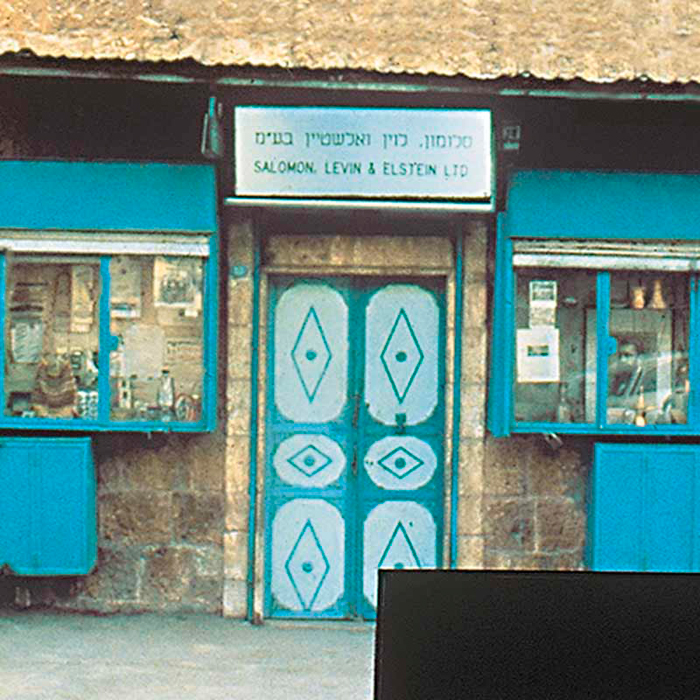
The beginning of what would become Teva Pharmaceuticals in 1901. Image via Teva
Eventually, they moved into drug manufacturing, and between 1980 and 2000, they grew internationally. Today, they are the largest generics pharmaceutical company in the world.
In 2016, with more than 43 000 employees, Teva Pharmaceuticals embarked on a new brand identity strategy[2].
Beck Codner, Group EVP, Corporate Marketing and Communications, said, “Only when we are confident that all our employees are aligned around a shared purpose and how that should be reflected in how we think and how we act, will we be ready to externalise our new brand”.
As part of the new brand strategy, the Teva brand style guide and code of conduct was developed, so that employees would be well informed, empowered and armed with transparent standards to work with and represent the brand.
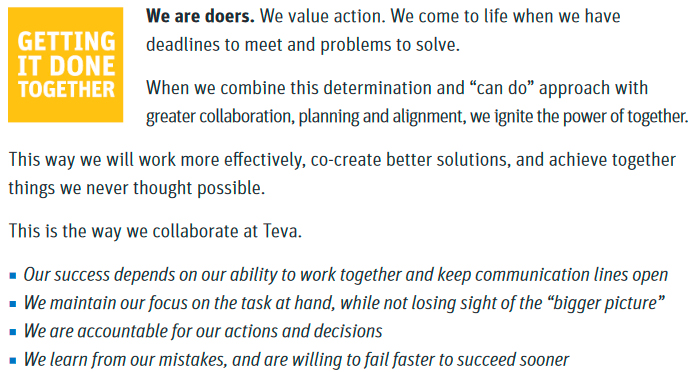
A screenshot of a section of Teva’s new code of conduct, based on their new internal brand strategy. Image Via Teva Pharmaceuticals
Watch Teva’s historical progress:
Focus On Marketing Your Brand Internally First
Whatever brand strategy, marketing or advertising you plan to activate externally, sell it to the inside first, and whatever communication is planned for your external market, customers and stakeholders alike, ensure you inform and induct your leadership team and employees first.
Why bother? Here’s one B2B example for the sake of clarity:
“Before you can do anything to gain success in your business, you’re going to need the buy-in and support of your team. A team is what grows the business. It’s not the technology; it’s not the computers.”
according to Yaniv Masjedi, Vice President of Marketing, Nextiva, a cloud based communication company.[3]
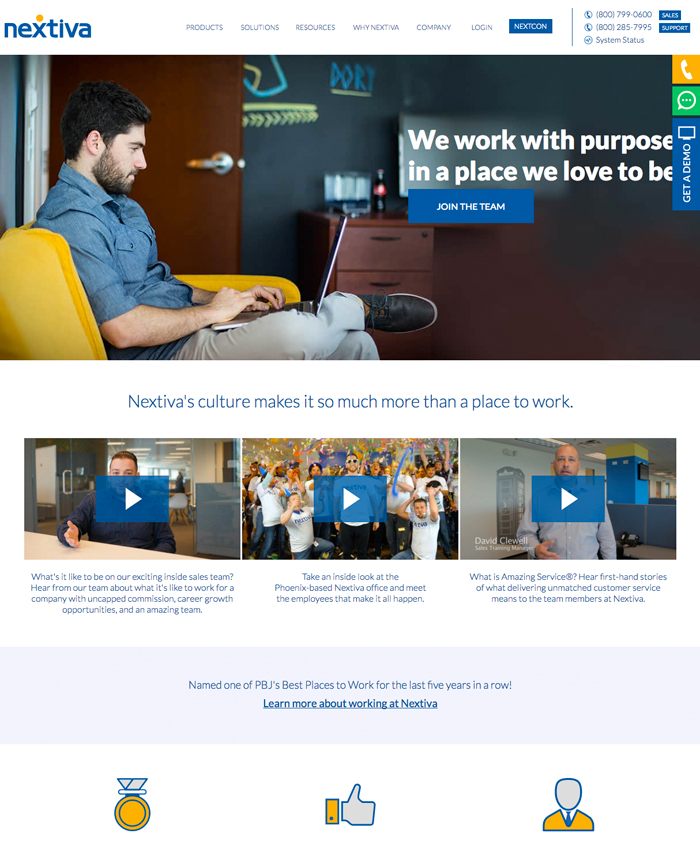
Image via Nextiva
In 2008, when Nextiva just opened its doors with a handful of staff, it was easy to keep people emotionally bonded to each other and the company. As it expanded to 300, with employees situated in other locations and many not knowing the names of fellow colleagues, it became necessary in 2012 to find a way to communicate company news more effectively, without resorting to the old fashioned newsletter.
“NexTV”, a weekly, internal video series was launched. They started small; each week, different employees would gather around a laptop camera to make announcements collected from all departments. Just 2 minutes long, it was uploaded onto YouTube – edit-free – for internal viewing. This killed two birds with one stone, so to speak because people in various locations could see the faces of fellow colleagues, some of whom they had never met, and get the news at the same time.
On average, 74% of Nextiva’s employees watch the series each week, with a 96% engagement rate.
The concept generates office fun and excitement, especially when employees know they’re being featured in the next episode.
Related: The Impact of Company Brand Culture On Driving Performance and Increasing Sales
In 2013, Nextiva started using more sophisticated means of internal communication, but the no-frills laptop camera method certainly achieved its purpose and has become a cornerstone of the company’s brand culture.
An example of one of the NexTV episodes.
Now logically, you’d think to sell change or marketing internally first, is a natural course of action, but for the majority of businesses, it’s not, because its importance is overlooked or forgotten. This is fatal for organisational goals, bottom line performance and sales growth.
Ensure management teams and staff are highly informed, fully engaged and relate to what’s happening before executing strategy externally, and if you make changes, be sure to sell it to them first.
Related: From Zero to Hero; How To Become a Must-Have Brand
Making Your Brand Come Alive for Staff Through Internal Branding
The point of branding – externally as well as internally – is to form an emotional connection with your ideal primary customer. This is why it’s no good simply documenting a dry vision, mission and values statement and filing it away or allowing it to become a wall dust-catcher because that accomplishes nothing. The vision, mission and values have to come alive for every staff member in order to increase performance and sales.
Related: Brand CSR: The Business Case for Successful Branding and Social Good
Staff have to live your brand and feel an emotional connection with it in order to sell it to your ideal customers whether in a formal work capacity or informally through their external life interactions.
Easier said than done; this section alone requires strategic thought: how do you make the brand come alive for your employees?
Firstly, the primary message needs to be introduced and the rationale behind it shared. This must be carefully developed because people are naturally resistant to change. When certain key factors are in place though, it makes the internal brand launch more readily received.
Secondly, the newly refreshed or revitalised brand message needs to be reinforced throughout employee touch points in daily activities. This needs to be strategically planned, just as you would plan a full-on customer marketing strategy.
Questions the brand strategy team needs to consider and plan around are:
- What do employees think of the brand and company?
- What do we want them to think?
- What will convince them of this?
- Why should they believe us?
Once these questions are evaluated and answered, the creation of internal branding collateral can be initiated. You don’t want to convey information, you want to persuade, emotionally engage and motivate. Make it actionable, fun, engaging and interesting.
Related: Brand Renaming: Name and Tagline Change Considerations
The Role of Communication In Internal Branding Strategy
It is often the HR department who execute internal communications when it should be the role of the marketing department who have the skill to market the brand not only to customers but to employees alike.
Communication is key internally, and yet the majority of businesses fail dismally at it.
In the 1980’s, HSBC, one of the largest financial organisations in the world, experienced rapid growth, and as a result, their employees became disconnected amongst themselves, the organisation and its leaders. In addition, the organisation had a traditional top-down approach, which made it just about impossible to obtain feedback from those on the ground. In today’s world, it’s not always an ideal model for a highly innovative, rapidly growing more progressive company which builds with high employee engagement.
The challenge was, how to get 250 000 people in one organisation, to be heard and feel their feedback mattered, and to change the traditional hierarchy?[4]
Enter Exchange Forum; the objective of which was to change the role of management.
Related: Brand Audits – How to Use One to Grow Your Profits
Internally known as the “shut up and listen” project, the forum was kicked off by holding meetings where management needed to “shut up” and listen to what their staff were saying, while saying nothing in return, so that the information would come from the bottom up instead of from the top down, recognizing that employees have opinions and knowledge that would be important to management decisions, especially for strategic changes.
The long term goal is that every employee should attend and participate in at least four “shut up and listen” exchanges each year.
Has the project worked? Take a look at this next video by HSBC titled, “through the eyes of our people”, and then answer this: from this video, does it appear as if employees feel connected now instead of disconnected?
Today, at HSBC, employees feel heard and leaders have learned the value of listening to what their team has to say.
Questions to consider with your internal branding
Is it time to sell your brand more strongly from the inside out? Consider these questions to improve clarity:
- Does your business sell its vision, mission and values to your employees first?
- Is your HR or Marketing department responsible for internal communications and are they integrated — working as a cohesive team?
- Can your staff and leadership articulate what your brand stands for and what makes you different to your competitors?
- Is your brand a living entity with a clear vision underlying at the heart of everything you do? Do your staff know how to incorporate the vision into their daily tasks?
Want to develop your internal branding strategy so you can build your team into your high performing brand champions but you’re not sure where to start to get a successful return on your investment?
Just drop us a line to [email protected] or give us a call T: +353 1 8322724 (GMT 9:00 – 17:00) — we’re here to help.
If you want direction and support transforming your internal branding strategy so it empowers your team and increases sales then the Persona Brand Building Blueprint™ Mastermind is the perfect fit for you.
This is a two-day brand building intensive shared with a small group of like-minded peers where you work on your brand with our leadership. In fact, over the two days, you reevaluate your brand, codify it and create your brand strategy from the ground up whether you’re revitalising an existing brand or creating a new one.
This is a highly empowering workshop where we take a deep dive, step-by-step into how to build a brand. You discover and apply the systems and methodologies used by some of the world’s greatest brands as you work on your brand under Lorraine Carter’s direction and tutelage so you can grow your own brand and business.
This is not a theory based program but a highly interactive fast-track course where you work intensively on your brand throughout the programme duration using our ten step system to:
- Completely re-evaluate your brand to make it much stronger so it’s highly visible enabling you to increase your profits
- Map out your brand in full so it’s codified and comprehensively documented to grow your business faster
- You leave with your total brand road map or GPS of your brand empowering you to manage your brand, stand out and attract your ideal customers so you multiply your sales
Outcome:
Your brand transformed so you can increase sales.
At the end of the two-day Persona Brand Building Blueprint™ Mastermind you leave with your fully documented brand strategy ready for implementation in your business or organisation.
If your team is larger and you’d like to include everyone’s’ participation in the Persona Brand Building Blueprint™ Mastermind then we also run in-house private client brand building intensive programmes too.
Ring us to discuss your brand building preferences
Just drop us a line to [email protected] or give us a call T: +353 1 8322724 (GMT 9:00 – 17:00) to discuss your preferences and we’ll develop your brand building intensive bespoke to your particular brand requirements so that you’re empowered to develop and lead your internal brand building team.
[1] https://www.brazen.com/blog/archive/uncategorized/2-million-people-apply-work-google-year-heres/
[2] http://www.tevapharm.com/news/teva_pharmaceuticals_embarks_on_strategic_corporate_identity_program_to_build_a_global_brand_02_16.aspx
[3] https://www.marketingsherpa.com/article/case-study/internal-marketing-b2b-video
[4] http://www.gatehouse.co.uk/the-employee-communication-revolution-ripping-up-the-rule-book-at-hsbc/
The Impact of Company Brand Culture On Driving Performance and Increasing Sales
/2 Comments/in Brand Culture, Brand Experience, Brand Innovation, Brand Loyalty, Brand Positioning, Brand Profiling & Positioning, Brand Refresh, Brand Relaunch, Brand Revitalisation, Brand Values, Rebranding /by Lorraine CarterMost leaders and employees would view company brand culture as a crucial part of job performance and satisfaction coupled with great customer service, yet for so many brands it remains an elusive concept.
We all know intuitively that a bad company culture produces bad results and there are plenty of statistics to back this up. One Columbia University study shows that the probability of job turnover when a brand’s company culture is poor is 48.4%, compared to just 13.9% when the brand culture is perceived as a good one.[1]
In fact, good corporate brand culture fundamentally drives financial performance as evidenced by the research published in the book ‘Corporate Culture and Performance’ by HBS Professor James Heskett and Kotter International[2]
| GROWTH | Average Increase for Twelve Firms with Performance-Enhancing Cultures | Average Increase for Twenty Firms without Performance-Enhancing Cultures |
| Revenue Growth | 682% | 166% |
| Employment Growth | 282% | 36% |
| Stock Price Growth | 901% | 74% |
| Net Income Growth | 756% | 1% |
“Great companies that build an enduring brand have an emotional relationship with customers that has no barrier. And that emotional relationship is the most important characteristic, which is trust.”
Howard Schultz, Starbucks
Culture matters because it’s about transparency, company behaviour, what you stand for, who you are. Brand Culture is how you convey, share, and translate that into your brand. It’s what every employee believes, does, and lives to express that culture.
Brand culture is driven by the fundamentals of your brand profiling i.e. what your brand stands for, it’s personality, mission, vision, values, purpose and way of doing things.
It’s about building a relationship between your culture, which may be developed over time but should ideally be guided from the top, the founder, owner or CEO — the visionary behind the brand — and your brand itself in terms of its personality, how it does things, the customer experience it creates and what it stands for. How you develop them to create a strong positive and distinctive brand experience.
Related: CEO Brand Leadership, How Vision Drives Brand Growth
There are also bad cultures within businesses and organisations which are not positive brand experiences. These poor brand cultures undermine performance, productivity, the whole perception of the organisation, the brand and negatively impact sales.
Our experience working with many different companies and organisations across diverse sectors clearly illustrates that it’s not that they haven’t considered company brand culture, it’s that developing and implementing something perceived to be so abstract can be difficult.
Related: Top 10 Brands for Customer Experience and What You Can Learn From Them
Because of this apparent client challenge we’ve pulled together some tangible ways you can start working on and developing your brand culture together with case studies from worldwide brands to show you ‘brand culture’ in action in the ‘real world’.
They’re brands who, like us, understand that building culture is not about placing a ping-pong table in a rec room, it starts with strong brand values that respect your employees and customers alike.
12 Ways To Improve Your Company’s Brand Culture so You Increase Performance and Grow Sales
1. Don’t be Afraid to Mix Marketing with People
Based in Kansas and proud of its community roots, CornerBank, now part of RCB Bank, describes itself as the bank that is “on your corner and in your corner”.[3] Their approach to culture and marketing lies in people, something which RCB Bank is trying to emulate since their merger last year.
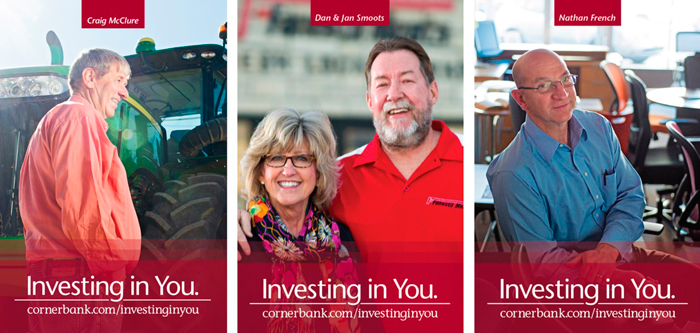
Image via CornerBank
CornerBank practised what they preached by combining the head of HR and the head of marketing into one role because their “people are their best marketing tool”.[4] While it’s undeniably an unorthodox way of structuring a company, in doing so, they put faith in their staff, and most importantly, their staff’s commitment to upholding those community roots. It’s a company that looks out for the little guy and ensures that its employees identify strongly with this.
2. Bridge the Gap Between Employee and Customer
With a client retention rate of a near-perfect 97.8%, bank and insurance provider, USAA is one of the most reputable and trusted brands in America.[5]
They have a unique proposition in that the vast majority of their customers are active or retired US military. No one knows their customer better than USAA and the company instils this in their employees by training them in the experiences of a soldier.[6]
This works in two ways. Firstly, for company culture, it gives employees insights that help them do their job better, which improves job satisfaction, and challenges them in the right way. And secondly, it shows customers that their experiences are genuinely important to the brand as a whole, but also that the people who they reach out to for service are much better equipped to deal with their situation. For soldiers trying to do their banking from war zones, that is often a pretty unique one.
3. Foster Fun and Creativity
When you think of best practice company culture, tech companies tend to come to mind. They seem to understand the important connection between having fun and innovating. Squarespace embodies many of the principles of best practice company culture – an attractive office space, very few levels of management, celebrations, downtime and flexibility.
What’s important here is that these practices stem from the company’s respect for its employees. This is the approach we take when we are working with clients. Downtime and flexibility show employees that they are respected enough to get on with their job and exercise a certain amount of autonomy.
Related: Use Humour in Branding to Create Strong Emotional Bonds so You Increase Sales
The fun aspects of this company’s culture are layered on top of this to let employees know that their work is appreciated. This two-pronged approach ensures that your company brand culture is engrained as a real living experience for everyone and not just lip service.
4. Offer Flexibility
Flextime is not a particularly new concept, and you’ll find it especially prevalent in public service organisations and progressive companies in western countries. Because of this, extensive research has been conducted to measure the value of offering this to your employees.
A survey conducted by The Alternative Board (TAB), an international provider of executive peer advisory boards, of hundreds of business owners, found that business owners who thought that their company culture was ‘strong’, also offered their employees flexible conditions, particularly in terms of time and remotely working.[7] We tend to find that when workplaces concentrate on results, project completion, and quality of work, the perceived ‘drudgery’ of the 9-5 work culture is eliminated, and employees feel part of something bigger which engenders a greater sense of job satisfaction.
Medium-sized British activewear company, Sweaty Betty, embodies these principles by using open communication and showing that they understand their employees have life commitments in addition to their work ones. “We trust our team and operate on a flexi-hour policy,” says Jessica Howden, people and events coordinator. “If a team member would rather leave earlier in the afternoon because of a long commute, they can start earlier in the morning. Our working hours are not set in stone.”[8]
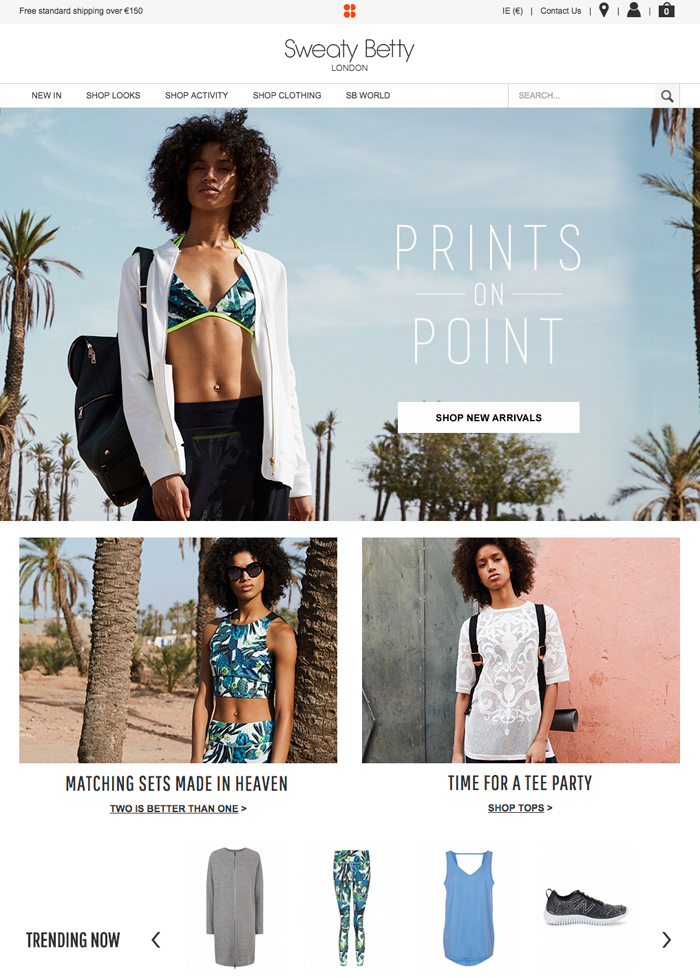
Image via Sweaty Betty
5. Build Brand Relationships to Create Community
Ask any social scientist, the key to happiness among employees in a workplace is when they feel like they are part of something bigger that makes a difference. Apple and Nike exhibited this in their September 2016 keynote where they teamed up to introduce the second-generation Apple watch. This is a watch that allows people to be part of two tribes – the Apple tribe, and the Nike Running Club tribe.
Aligning with another brand that commands respect and complements your brand values and positioning promotes inclusivity in your workplace and makes your employees feel like they are part of something larger than themselves. It also strengthens your brand in the mind of your customer and leads to commercial growth – advocates of one brand will be more likely to become advocates of the other when they are aligned.
When we work with companies to identify co-branding opportunities, having a strong brand culture or value fit is essential. Some of the most effective brand collaborations and alignments are not even necessarily in the same industry. This can yield great results for SMEs where the primary focus is to stand out, increase brand awareness with sales and reach new audiences.
Related: Co-Branding, 13 Tips for Growing Your Brand Through Strategic Partnerships
6. Hire ‘Your’ People
Traditional recruitment is generally based on skills and experience. Our approach to recruitment for your brand is to ascertain a baseline level of aptitude that you would consider mandatory, and place more emphasis on finding a suitable fit with your organisations brand culture.
Recruitment companies, such as New Zealand-based company, Weirdly, take an innovative approach to recruitment using a series of tactics to assess a potential employees culture fit before they even get to the interview phase. In doing this, you create a workplace where people feel a sense of belonging, as well as the crucial creation of an environment where ideas can be shared.
7. Employees as Brand Ambassadors
As we’ve mentioned, most companies will try to hire employees who reflect and embody their company’s values in some way. Increase engagement with your brand and create authentic communication by making it attractive for your employees to become brand ambassadors.
According to the 2016 Edelman Trust Barometer “Employees rank higher in public trust than a firm’s PR department, CEO, or Founder. 41% of us believe that employees are the most credible source of information regarding their business.”[9]
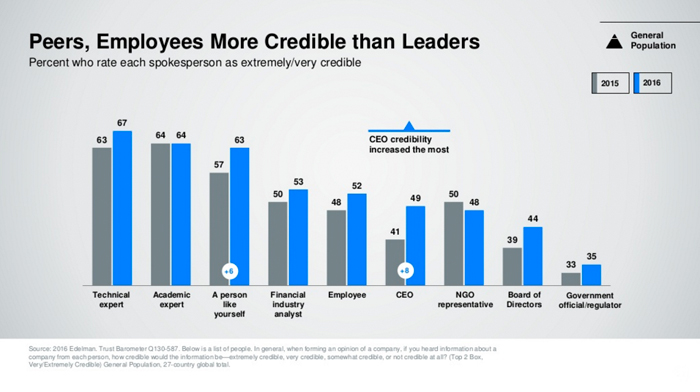
Image via Edelman Insights
We believe that this likely stems from the perception that employees are much more likely to voice their honesty, particularly if they are disgruntled. An employee that is openly endorsing a company is viewed as a trustworthy and reliable opinion. Social media is a great platform to try this on. Creating environments where employees feel compelled to share the goings-on of their workplace on their personal channels speaks volumes, and is a great place to start.
American-based retailer, Zappos, has an infamous reputation for its focus on employee culture. “At Zappos, we really view culture as our No. 1 priority. We decided that if we get the culture right, most of the stuff, like building a brand around delivering the very best customer service, will just take care of itself.” Tony Hsieh, CEO, Zappos–January 9th, 2010, The New York Times[10]
Related: Brand Sponsorships: The Best Brand Ambassadors Are Already On Your Payroll
8. Give Your Audience a Sneak Peek into Your Culture
In a similar way, don’t be afraid to shed a little light on how great your company is behind the scenes. Doing so increases your brand value with your customers and gives employees a public reason to feel proud of where they work. Your customers could also be your potential employees.
Just ensure that what you are posting accurately reflects your brand values as a company and how you want people to perceive it. ASOS is a great example of this – they use their Instagram account to provide sneak peeks into their workplace culture. It injects personality into the brand and shows that they value their employees.

Image via ASOS on Instagram
9. Remove Restrictive Hierarchies
Hierarchies are a particularly tricky area of company politics to navigate. We tend to look at hierarchies not from a ‘have them/don’t have them’ perspective, but rather explore why you have them, what purpose they serve and, most importantly, whether they are restrictive. Closed door policies can inhibit the flow of ideas and creates an ‘us and them’ culture, which is intimidating and often counter-productive.
While your brand needs a leadership team, and there will be things that the leadership team knows that employees aren’t privy to, there are ways to create an open and flexible environment.
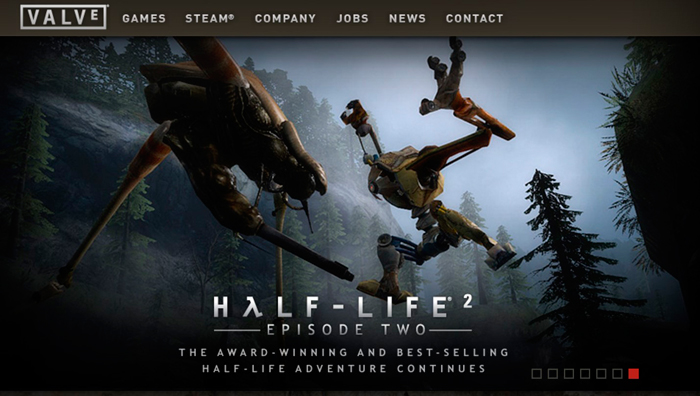
Image via Valve Software
SME, Valve Software[11], does this well – they have no managers, projects are started when an employee can group a team together, and performance management is conducted as peer review. As a result, Valve has experienced tremendous growth – something that would normally require rigidity to manage.
10. Make Your Employees Part of Your Brand Mission
Create an atmosphere where employees feel like they contribute to the outcome of your company or organisation. Environments where staff feel like they are part of something bigger than themselves have been constantly proven to be success-drivers. Results happen when everyone is invested.
So, how do you go about this? Our approach is to create a great brand and strategy communication from the top down. Internal communication should be tailored so that, no matter the structure of your company, each employee knows how they contribute to wider goals, and, most importantly, has a clear idea of what those wider goals are.
Including corporate social responsibility into part of your operations is a great way of tangibly showing both customers and employees that your company is committed to the greater good.
Relate: Brand CSR, The Business Case for Successful Branding and Social Good
Ice cream giant, Ben & Jerry’s, demonstrates that ethics are not just for the realms of small, niche enterprises by only using fair trade ingredients.[12] In strengthening their customer’s positive perception of them as a company, they increase employee morale, drive purchases, and ensure that their brand personality doesn’t fall into the trap of becoming disconnected with consumer’s needs.
Related: Personality Matters: Bringing Your Brand to Life to Grow Profits
11. Give your employees what they need
This is the proof point that your company is not just about placing that ping-pong table in the rec room. Showing employees that you value them and their lives as people, not just workers, vastly increases job satisfaction.
71% of staff at Goldman Sachs feel that they often or almost always receive great rewards, while 82% of American Express employees report that the company often or almost always provides needed training, fair promotions and personally challenging work.[13] While it’s not the glamorous, fun side of company brand culture, creating a base that ensures that your employees know they are valued through things such as child care, mentoring and health, can make a dramatic difference.
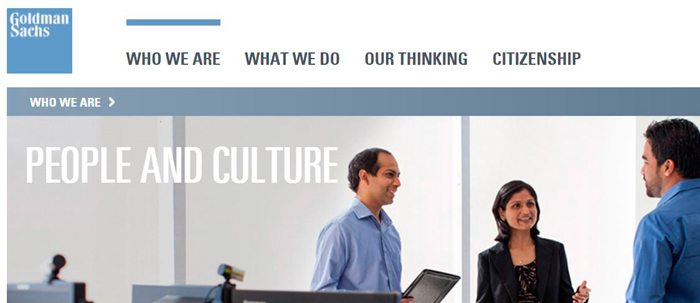
Image via Goldman Sachs
12. Create Autonomy
Career analyst, Dan Pink, has spent much of his own working career studying what it takes for employees to be motivated. It turns out, creating an environment where employees feel that they are the ‘masters of their own destiny’ is one of the most important aspects of employee happiness. This can be relatively easy to establish if the work is naturally project or campaign based, so thought should be given particularly to the roles where work is more constant and not as varied.
For instance, a Web Content Manager at an SME spends their day ensuring that the content is relevant, accurate and appropriate for the company. A company with a poor brand culture will treat this Content Manager as a worker, one who processes and publishes the team’s work, whereas a company with a great brand culture will instil autonomy in the Content Manager. They own the content space, feel comfortable providing advice and direction, and are looked to as the expert in that field. A small change, but one that makes a huge difference.
Related: Family Business Branding and The Secret Drivers to Brand Success
Brand culture integrates itself into every part of your company from the way customers perceive your company and trust you, which in turn has a massive impact on their likelihood to buy and become brand advocates, to your own employees’ sense of job satisfaction.
If you’re struggling to strongly develop your brand culture in order to improve your overall performance, growth and profitability, then a brand audit is a very useful tool to help you evaluate your areas of strength, weakness and potential innovation and growth.
Take a look at our brand audit programme called the Auditing Analysis Accelerator™. This online course takes you through all the key steps you need to consider in giving your brand a health check. It enables you to identify areas of strength, weakness and pinpoint new opportunities for innovation and growth. You can watch a free course preview here.

Audit your brand now so you can identify where and how to build your strong brand culture
Alternatively, if you’ve got a major challenge on your hands then perhaps a brand revitalization or refresh may be the most effective option to turn things around. Feel free to get in touch, we’d be delighted to help. Drop us a line to [email protected] or give us a call T: +353 1 8322724 (GMT hours 9:00-17:00).
Viewing your workplace as a mutually beneficial environment, one that adds value to both the employer, employee and customer is crucial to job satisfaction, role performance and customer satisfaction, which are what collectively drive growth and achieve strong commercial results.
There are so many ways that SMEs / SMBs can add value to their employees’ lives by providing them with the benefits and autonomy they need, to creating a fun and inviting environment that instils a sense of pride and appreciation. We can help you uncover and articulate your brand values, and most importantly, how to actually achieve them in your organisation in an authentic way that enhances your peoples’ lives while also increasing your profits.
Questions to consider
- Have you evaluated how you can improve your brand culture to attract and retain high performing talent so you can increase your brand awareness, market share and sales?
- When did you last give you brand a health check so you can identify areas of weakness, strength and where to innovate?
- Could you give some members of your team more autonomy to increase their motivation, performance and sense of fulfilment?
- Have you trained your staff and fully inducted them in what your brand stands for and what that means in a day-to-day actionable, living sense so you can improve their performance, brand alignment and the quality of the customer experience delivered?
- Is now the right time for a brand refresh so you can improve your brand culture, re-invigorate company morale and increase overall market impact and growth?
Want to refresh your brand but you’re not sure where to start to get a successful return on your investment?
Drop us a line or give us a call… we’re here to help!
If you want direction and support transforming your brand so it fully embraces changing trends and increases sales then the Persona Brand Building Blueprint™ Mastermind is the perfect fit for you.
This is a two-day brand building intensive shared with a small group of like-minded peers where you work on your brand with our leadership. In fact, over the two days, you reevaluate your brand, codify it and create your brand strategy from the ground up whether you’re revitalising an existing brand or creating a new one.
At the end of the two-day Persona Brand Building Blueprint™ Mastermind you leave with your fully documented brand strategy ready for implementation in your business or organisation.
If your team is larger and you’d like to include your full team’s participation in the Persona Brand Building Blueprint™ Mastermind then we also run in-house private client brand building intensive programmes too.
Ring us to discuss your brand building preferences
Just drop us a line to [email protected] or give us a call T: +353 1 8322724 (GMT 9:00 – 17:00) to discuss your preferences and we’ll develop your brand building intensive bespoke to your particular brand requirements so that you have your brand solution built to greatly enhance your brand culture and secure your future success.
[1] https://www.entrepreneur.com/article/238640
[2] https://www.forbes.com/sites/johnkotter/2011/02/10/does-corporate-culture-drive-financial-performance/#7fb4ea207e9e
[3] https://hbr.org/2010/09/brand-is-culture-culture-is-br
[4] https://hbr.org/2010/09/brand-is-culture-culture-is-br
[5] https://www.bloomberg.com/news/articles/2010-02-18/usaas-battle-plan
[6] https://hbr.org/2010/09/brand-is-culture-culture-is-br
[7] http://www.businessnewsdaily.com/5935-improve-company-culture.html
[8] http://www.telegraph.co.uk/sponsored/business/britains-healthiest-company/11848497/flexible-working-hours.html
[9] https://www.forbes.com/sites/williamarruda/2013/10/08/three-steps-for-transforming-employees-into-brand-ambassadors/#5f8f0e9e1040
[10] http://www.inc.com/ananya-bhattacharya/tony-hsieh-on-company-culture.html
[11] https://www.inc.com/david-burkus/how-this-company-runs-without-managers.html
[12] http://www.businessnewsdaily.com/4679-corporate-social-responsibility.html
[13] https://www.entrepreneur.com/article/245667
CEO Brand Leadership: How Vision Drives Brand Growth
/0 Comments/in Brand Culture, Brand Leadership, Brand Strategy, Customer Service, Entrepreneur /by Lorraine CarterIn shaping a brand, CEO brand leadership plays a critical role as the visionary behind the brand. Leaders with vision are aspirational; they stretch the imagination and they look to the future. They understand that a vision is not just a statement; it’s a process. It’s alive. It changes as the world presents new opportunities. True leaders embody and define a brand vision and culture, which must be shared and cultivated to exist.
It’s worthwhile examining lessons from three of the most influential, visionary, and successful CEOs of our times:
- Jeff Bezos continues to break records leading the fastest-growing company in world history.
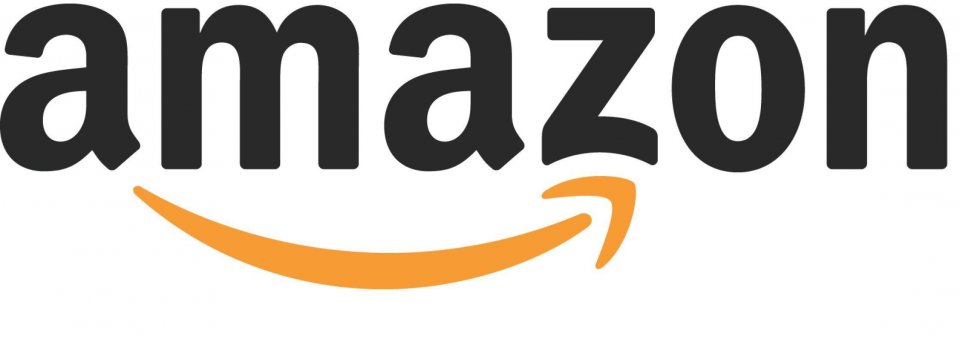
Image via Amazon
- Steve Jobs developed the first personal computer and laid the foundation for the world’s highest-valued company.

Image via Apple
- Bill Gates, the world’s wealthiest individual, built the world’s first software company and is now running the world’s largest private charitable foundation.[1]
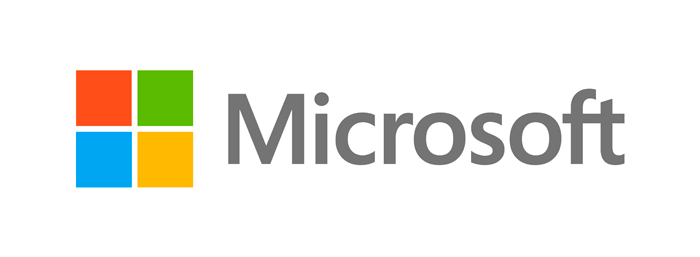
Image via Microsoft
Not all visionary CEOs are corporate giants, of course. Sectors such as nonprofits, services, and even political parties also require leaders with exemplary vision. And it’s not uncommon for entrepreneurs and startups to be guided by a founder whose passion results from personal experience that is shaped into a brand vision.
Related: CEO Brand Leadership – How Does Your Leadership Impact Your Brand?
Visionary Branding: CEO Brand Leadership Must See Tomorrow
Regardless, in all cases it is the CEO’s responsibility to own the vision, to effectively communicate the vision, to provide the resources to deliver the vision, to authentically support the vision, to engage in dialogue with stakeholders, and to continually refresh and drive the brand vision.
Branding that reflects a vision is key to a company’s long-term survival and market leadership and success. It may be time for you shape your brand strategy to rebrand, refresh or relaunch. Talk to us about taking the next step to re-shape your vision and align your branding to ensure its long term health and growth. |
Related: A Rebranding Strategy Guide for Brand Owners and Managers
Strong Brand Culture: Shaped by The CEO’s Brand Leadership Vision
It’s well known in Silicon Valley circles that in the months leading up to Facebook’s IPO in 2012, a slogan was painted on the wall at headquarters proclaiming, “Done is better than perfect.” That underscores the company culture in a brand that didn’t exist before 2004. Now Facebook has over 1.86 billion monthly active users run by a 32-year-old founder and CEO who ranks as the world’s fifth wealthiest individual.[2]
Related: 10 Branding Tips From Silicon Valley on How to be a Successful Startup Brand
“When we first launched we were hoping for maybe 400 or 500 people…so who knows where we’re going next?” a 19-year-old Mark Zuckerberg told CNBC about his new college social networking site that had achieved 100,000 users in 2004. “Maybe we can make something cool.”
While the words “company culture” are bandied about quite a bit, one Melbourne-based international consultant cuts through the jargon to explain the concept succinctly. “For example, if it is 5 o’clock and you are walking out the door and the phone rings – if you care about the goals of the business you will pick up that call.”[3]
That level of employee care, explains Didier Elzinga, CEO of Culture Amp, has its roots in the leadership. While the CEO cannot sit in on every meeting, corporate culture is intrinsically linked to leadership and trust.
Companies and workers either have it or they don’t, says Elzinga, after studying 600 firms representing more than two million employees.
Ultimately, successful leaders shape their company culture, they do not allow the company to shape their vision. Modern business analyses indicate that “the way things work around here” is driven day-to-day from the top, deeply embedded in processes, reward systems, and behaviors.[4]
Related: What’s a Cult Lifestyle Brand and How do You Create One?
As a case in point, we only need to look to the headlines following events of April 2017, when United Airlines’ CEO made a reportedly bad situation infinitely worse by publicly doubling down on company culture, citing terms and conditions instead of responding with sincere apologies. “I’ve learned,” says Oscar Munoz, about what he refers to as his “shame and embarrassment.”
Brand Survival: CEOs Must Keep the Ship Afloat
In the influential bestseller, “The Innovator’s Dilemma: When New Technologies Cause Great Firms to Fail,” author Clayton M. Christensen noted that companies must consistently disrupt their existing product lineup with “the next new thing” in each of the categories in which they compete.[5]
Related: The Power of Disruptor Brands and Challenger Brands
To ensure survival, a CEO must see tomorrow and infuse (and re-infuse) the brand with an evolving vision. Today, this is even more critical than when Christensen’s book was first published in 1997. Astonishingly, the average life expectancy of a Fortune 500 company has declined from around 75 years half a century ago to less than 15 years today…and it is declining all the time.[6]
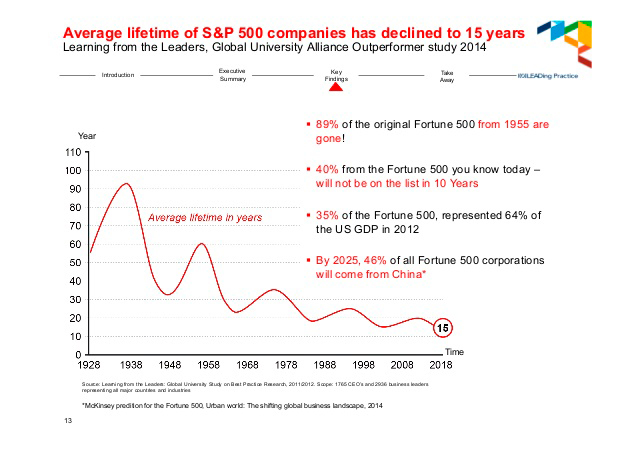
Brand Vision: When the CEO is Customer-Centric
Amazon, Apple, Microsoft: Dedication to a superior customer experience is the thread shared by extraordinary leaders like Jobs, Bezos, and Gates.
Jeff Bezos founded Amazon.com to be the “Earth’s Most Customer-Centric Company.” When in 2005, CustomerThink awarded the internet giant with a customer-centric leadership award, Amazon responded with, “It is simply in our DNA to approach our business by starting with the customer and working backward, and for the past 10 years we have stayed laser-focused on this core principle.”[7]
Bezos says you can have one of 4 primary business focuses:
1. Competitor focus
2. Product focus
3. Business model focus
4. Customer focus
In Bezos’ view, constant customer focus yields the best returns and it’s fundamental to his brand vision and the whole Amazon brand culture. Because customers are endlessly dissatisfied, a company that obsesses about its customers happiness is constantly lifting the bar on the quality of the experience and inventing new ways to please. Together, these actions lead to superior results.
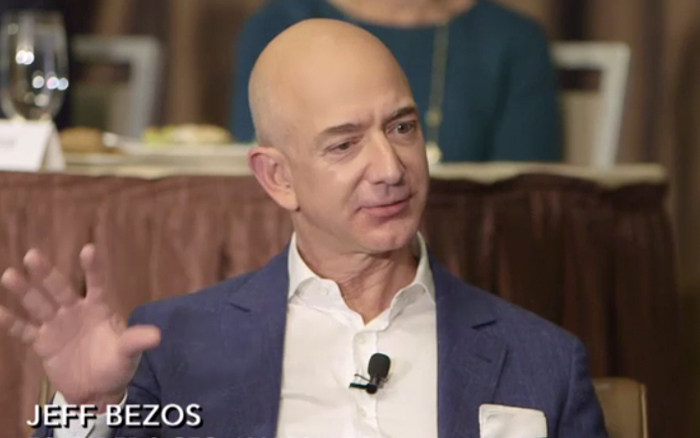
Image via CharlieRose.com
Early Amazon employees could tell you about the empty chair at the conference table, placed there to represent the customer, “the most important person in the room,” according to Bezos. “The thing that connects everything that Amazon does is customer obsession,” Bezos explained in a 2016 interview,[8] recalling that Amazon used to only sell books and he drove the packages to the post office himself. With a net wealth of $75.6 billion, he may have a point.
Related: Top 10 Brands for Customer Experience and What You Can Learn From Them
On his return to Apple 12 years after being fired, speaking at a Worldwide Developers Conference in 1997, Steve Jobs defined what he called “the right path” for his strategy and vision. “What incredible benefits can we bring to the customer? Where can we take the customer? It’s not starting with let’s sit down with the engineers and figure out what awesome technology we have and then how can we market that.”[9]

Image via Wikimedia Commons
Throughout his lifetime, this customer-centric approach remained at the heart of Jobs’ laser focus on every detail, in all the touchpoints and design elements of Apple’s products, including even internal ones that cannot be seen.
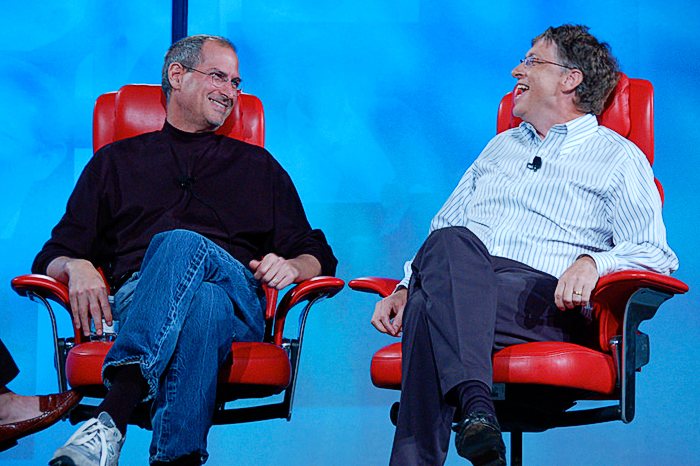
Steve Jobs and Bill Gates (David Geller, flickr 2.0)
Bill Gates on Steve Jobs, “He knew about brand in a very positive sense; he had an intuitive sense for marketing that was amazing.”[10]
And while happy customers are the goal, Bill Gates has commented on his own leadership at Microsoft, “Your most unhappy customers are your greatest source of learning.”[11]
Brand Success: CEO Brand Leadership Vision For an SME
The most important CEO function in a small-to-medium sized business is setting strategy and vision says Rushika Bhatia, Editor of SME Advisor magazine. “Lots of people can help the senior management team develop strategy. Lots more – including the investors and shareholders – can approve a business plan. Yet the actual direction, destination and market positioning can only be set by one person: the CEO.”[12]
In Silicon Valley, venture capitalist Ben Horowitz of Andreessen Horowitz is a startup expert who echoes this view. “The story of the company goes beyond quarterly or annual goals and gets to the hardcore question of why? Why should I join this company? Why should I be excited to work here? Why should I buy your product? Why should I invest in the company? Why is the world better off as a result of this company’s existence? Some employees make products, some make sales; the CEO makes visionary decisions.”[13]
Due to the smaller size of a startup or SME, a CEO is closer to internal functions, all stakeholders, and ultimately, customer experiences. At small-to-medium sized businesses, leaders have greater opportunity for direct control of the organizational climate and brand culture, hence interaction for delivering the vision. CEO advocates of the ‘customer first’ approach can directly influence that vision as the head of an SME.
If you want in-person professional direction to re-evaluate your brand or clarity on how to articulate what your brand stands for so you can sell more effectively and would like to explore working with us then drop us a line to [email protected] or give us a call T: +353 1 8322724 (GMT). We’d be delighted to talk with you.
Alternatively you can also build your brand yourself using our Personality Profile Performer™ programme so you can identify what makes it really different, distinctive and memorable to standout. This is a step-by-step brand building programme, complete with downloads, questionnaires and checklists, to help you build your brand. You can watch a section of the programme here.
Building a Brand From Scratch: An Innovative Ice Cream Story
In 2007, Robyn Sue FIsher had an MBA from Stanford University, no money, and a passion for ice cream. She started selling her Smitten Ice Cream brand on the streets of San Francisco from a Radio Flyer wagon to transport her innovative machinery.
As CEO, she now has three patents on a liquid nitrogen machine, 10 Smitten stores across California and 200 employees. The vision was to produce the best-tasting, wholesome, handmade ice cream from scratch, one scoop at a time, from all natural ingredients, using technology to get old-fashioned flavours.

Image via Smitten Ice Cream
In a podcast interview, Robyn says, “I get closer and closer to our amazing people as we grow. A lot of the things that make me sit behind a computer, which is not what I signed up for, can be handed off to people who can do them better than me so I can actually build our culture and be in charge of innovation. Growth enables me to shine and everyone else to take ownership and help steer the company.”[14]

Image via Smitten Ice Cream
Brand Loyalty and Longevity: A Natural Health and Wellness Story
Just one mile from Harvard Square, a husband-and-wife team started a natural health and wellness specialist store after graduating from college in 1974, and have been running Cambridge Naturals ever since. Co-founder Michael Kanter carries the title Chief Visionary Officer, embracing a belief “that strong employees are absolutely vital to a thriving business, and that improving our employees’ standard of living will in turn help our business to grow and prosper.” Leading by example, he has raised the business’ starting hourly pay to considerably above minimum wage plus 100% medical and dental benefits for full-time staff.[15]

Cambridge Naturals: Family business, Michael Kanter and Elizabeth Stagl with daughter Emily Kanter and son-in-law Caleb Dean
A founding member of Cambridge Local First, Michael has been actively involved in both federal and state campaigns to raise the minimum wage, hosting former Secretary of Labor Thomas Perez in 2014 for a local business roundtable on the impact of wages on employee and business health and success and writing about it for the U.S. Department of Labour Blog.[16]
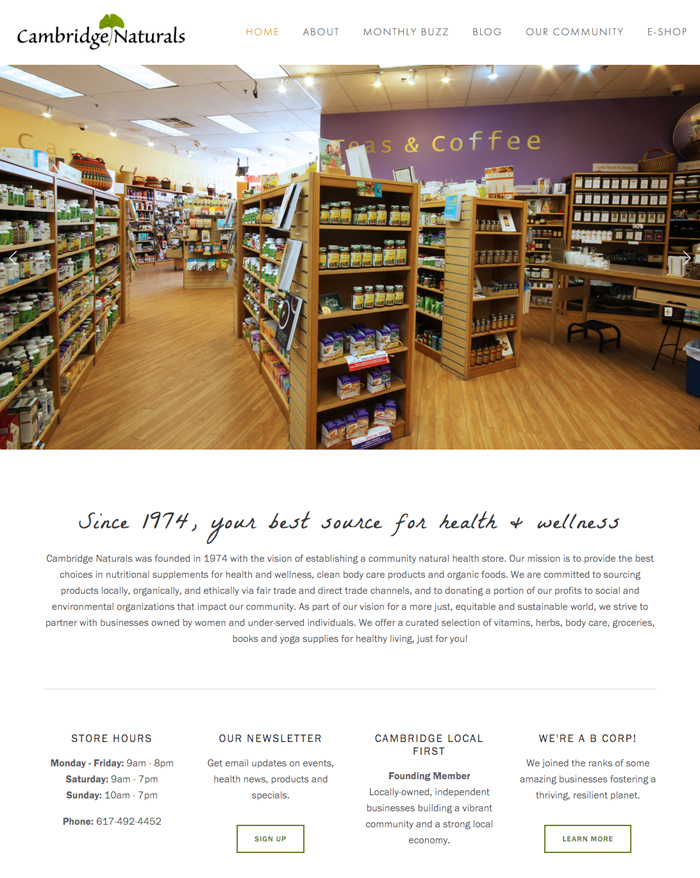
Image via Cambridge Naturals
Michael’s vision extends to consulting for other natural products businesses and speaking at industry trade events about the rewards and the struggles of running a locally-owned, community-oriented business.

Cambridge Naturals: Company Outing
Ultimate Brand: When the CEO is the Brand
In a family business, a small-to-midsized business, a larger firm, or even an entire nation, a founder and/or CEO’s persona can permeate the brand. Such a personification of brand vision can resonate far more deeply than a logo ever will, a tagline, or an advertising campaign. And it can be kept alive through generations. According to the U.S. Bureau of the Census, about 90 percent of American businesses are family-owned or controlled.[17]
Related: Family Business Branding and The Secret Drivers to Brand Success
Personal infusion or identity crossover can generate iconic status for the brand. Well-known examples of founders and CEOs who have personally underscored brand strength include Henry Ford of Ford Motor Company, innovator Walt Disney of the Disney Company, and entrepreneur Richard Branson, founder of Virgin Group.
The strength of vision from these three futurist dreamers has changed the world. Listen to Walt Disney’s daughter on the emerging vision of her father from the drawing board to Disneyland theme parks for children of all ages.

Image via Walt Disney
Hear Sir Richard Branson connect the dots between airplanes and his vision for space travel by millions of earth dwellers.
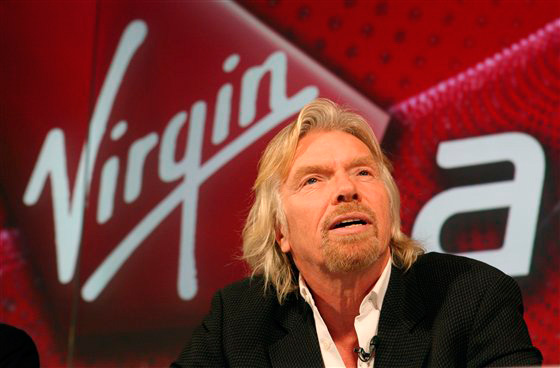
Image via Virgin
An elected head of state is perhaps the best example to most starkly illustrate how a leader’s personal stamp critically shapes a brand, in this case, the brand of a country.
Related: What Brands Can Learn From Political Campaigns
Think of the president of the United States or the prime minister of the United Kingdom, for example, as a CEO. This individual embodies and defines the vision for the national brand — including its perception at home and globally — with massive implications based upon their own individual vision.
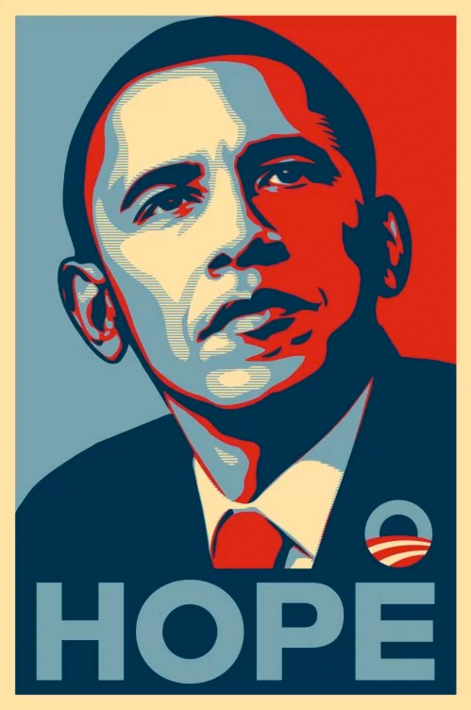
Image via Wikimedia Commons
When you realise that 60% of branding is about perception and only 40% about all the more tangible stuff, be that product or service, then the power of branding really hits home.
Are you a visionary CEO and have you considered?
- Do you feel confident expressing your brand vision succinctly and authentically — what your brand stands for?
- What are the leadership principles you most admire and who embodies them best?
- Do you both ‘talk the talk’ and ‘walk the walk’ as the visionary behind your brand and the face of your brand?
- How does your brand vision continually adapt to changing times?
- How well do you communicate your brand vision to all stakeholders? Can you clearly articulate what makes your brand different compared to your competitors — in terms that are compelling to both customers and stakeholders alike.
- Does your vision feel fresh and futuristic or is your brand ripe for a refresh?
If you need direction and support giving your brand a health check or brand revitalisation feel free to get in touch [email protected] or give us a ring T: +353 1 8322724 (GMT hours).
Alternatively you can also give your brand a health check yourself to identify its strengths, weakness and areas for potential innovation and growth using our Auditing Analysis Accelerator™ programme. This is a step-by-step walk through, complete with downloads, questionnaires and checklists, to help you audit your brand. You can watch a section of the programme here.

Start auditing your brand here
[1] https://www.forbes.com/billionaires/list/2/#version:static
[2] https://www.forbes.com/billionaires/list/2/#version:static
[3] https://www.siliconrepublic.com/jobs/cultureamp-ceo-brand-promise-culture-deliver
[4] https://dupress.deloitte.com/dup-us-en/focus/human-capital-trends/2016/impact-of-culture-on-business-strategy.html
[5] http://changethis.com/manifesto/149.04.LongTermGrowth/pdf/149.04.LongTermGrowth.pdf
[6] https://www.aei.org/publication/fortune-500-firms-in-1955-vs-2014-89-are-gone-and-were-all-better-off-because-of-that-dynamic-creative-destruction
[7] https://www.entrepreneur.com/article/234254
[8] https://charlierose.com/videos/29412
[9] https://www.youtube.com/watch?v=FF-tKLISfPE
[10] http://www.cbsnews.com/news/bill-gates-on-steve-jobs-we-grew-up-together
[11] https://www.surveymonkey.com/blog/2015/02/13/10-inspiring-customer-satisfaction-quotes-and-the-stories-behind-them
[12] http://smeadvisor.com/featured/leading-from-the-front-role-of-the-ceo
[13] https://a16z.com/2010/05/31/how-andreessen-horowitz-evaluates-ceos
[14] http://www.thebigleapshow.com/robyn-sue-fisher
[15] https://static1.squarespace.com/static/5366ed3ee4b0b47b799380bb/t/58500c0920099e4b52133b17/1481640969656/CNPressReleaseDec13+-+FINAL.pdf
[16] https://blog.dol.gov/2017/01/03/why-one-family-owned-business-decided-to-raisethewage
[17] https://www.inc.com/encyclopedia/family-owned-businesses.html
Rebrand or Refresh? That is the Question
/0 Comments/in Brand Audit, Brand Auditing, Brand Audits, Brand Culture, Brand Differentiation, Brand Personality, Brand Profiling & Positioning, Brand Revitalisation, Branding, Professional Services, Rebrand, Rebranding, Revamped Design, Revitalized Design, Uncategorized /by Lorraine CarterA Rebranding Strategy Guide for Brand Owners and Managers
The business world is in a constant state of flux. Markets change, new trends emerge, disruptive competitors alter longstanding rules, and customer preferences evolve — all of which impacts your brand. Consequently brands are constantly evolving to ensure future growth and relevance. Even the longest standing and greatest brands in the world need rejuvenation, if not a total rebrand, in order to maintain their market leadership.
Like the foundation upon which a house is built, a strong brand is essential, indeed it is the lifeblood for any successful organisation. When cracks appear in that foundation, a wise owner or manager must take action to repair, introduce procedures to prevent deterioration and take steps to strengthen the brand for future growth. Experts say that organisations and brands change their corporate identities on an average of once every 7-10 years. [1]
On a regular basis, diligent brand owners and managers need to take a step away from an organization’s day-to-day operations to examine and re-evaluate their position and strength in the market. If your brand isn’t achieving its objectives or driving business growth, there’s little time to be lost wondering what to do about it. Its time to give your brand a health check. Frequently asked questions about the two brand revitalisation routes include:
- What’s the difference between a brand refresh and a rebrand?
- How do I determine which one is the most suitable choice?
Rebranding or revitalization can take many guises from the complete wholesale change of a company, service or product, inside and out, including; name, culture, values, vision, mission, proposition, positioning, purpose, behaviours, tone, visual collateral and all that entails with no connections to the legacy entity. Alternatively, it can be something less dramatic and of a more subtle, evolutionary nature in the form of a brand refresh.
In each instance though, the change to whatever degree, be it a total rebrand overhaul or brand refresh, affects a change in the minds of the target audience in terms of their perceptions of the brand. That change is a process of giving an organisation, product or service a new meaning and image, both in terms of brand experience and culture to its visual brand collateral, in order to make it more successful.
In determining whether it’s time for a refresh or a rebrand, one of the most effective tools for re-assessing your brand’s state is a brand audit health check to examine external and internal drivers that impact your brand. Like any checkup, a brand audit is best done as a proactive and preventative measure. Aside from determining the health or state of your brand, a brand audit also helps determine the level of potential change required — to rebrand or refresh.
“A brand audit is effectively a health check of your brand to identify and address problem areas with a net result of helping you turn things around and grow your bottom line.
Brands are like living entities with life cycles. They start with much excitement and promise, grow and then eventually plateau. A brand audit helps you innovate, re-invent, re-invigorate, and ensure market leadership and continued relevance so you can maximise your commercial return and fend off your competition.
The scale and depth of a brand audit is largely determined by your primary objectives coupled with timelines and resources.”
What’s the Difference between Refresh and Rebrand?
The reasons for rebranding and or refreshing an organisation, product or service are numerous and decisions should not be taken lightly without sound strategic reasons before launching into the process.
Once you know why you’re considering either a rebrand or refresh and what your primary objectives are in making this strategic decision, consider the following differences:
Rebrand or Refresh? A Quick Reference Checklist
| Refresh | Rebrand |
| What: Expand reach and market impact, get new customers, attract new talent, increase profitability
Why: Declining market share, diminishing growth, changing client’s or customers needs, tired and dated with lack of brand relevance, insufficient new leads, significant new product/service launch, lack of brand distinction, entering a new market, aggressive new competitors, new technology changes, struggling to describe what makes your firm, organisation, product or service different, difficulty attracting new talent, competitors poaching key employees, need to take your organisation to the next level, change in brand architecture or hierarchy | What: A re-positioning to change market perceptions, re-evaluate who are we, why do we exist? What’s our mission, vision, values, promise? How do we define and articulate our brand proposition and purpose? How is our brand really different to our competitors?
Why: New ownership, merger or acquisition, legal issues, reputation damage, rationalisation, outgrowth, globalisation, new primary target audience(s), competition, new sectorial challengers and disruptors |
| What: Evolutionary logo update
Why: Better reflection of brand platform and values | What: New brand identity
Why: To streamline and simplify or a complete change in core business |
| What: Evolve, update tagline
Why: Tweak the message, spotlight the business, stay current, introduce a new brand promise reflecting enhancements provided by the business | What: New tagline
Why: New line of business, new audience or an innovative advancement, new positioning |
| What: Health check your brand personality and primary characteristics using brand profiling — elements reference check
Why: Increased competition, slower sales, insufficient brand relevance and resonance, create enhanced distinction and market recognition, develop stronger brand resonance with customers | What: Redefine your new brand personality and brand characteristics
Why: Make it more relevant, engaging, compelling, distinctive, different, memorable and referable |
| What: Evaluate your brand promise and enhance consistent delivery
Why: Customer feedback, lack of strong distinction, difference and referability | What: Change your brand promise
Why: As a result of new products, services |
| What: Re-evaluate customer base versus profitability, evaluate brand equity
Why: Customer research, re-evaluate existing buyer personas (customer profiles) | What: New primary audience, need to change existing or previous customer perceptions
Why: Customer research, develop new customer buyer personas |
| What: Build new leadership and employee training modules
Why: People represent the brand and need the knowledge to be effective brand champions | What: Revamp leadership and employee training programmes
Why: To interpret and support company culture, develop new brand ambassadors |
| What: Expand market share
Why: Changes in competitive set and customer wants/needs | What: Find and capture new customers
Why: Change of price point and positioning |
| What: Introduce new products, services congruent with primary offering
Why: Business expansion within existing customer base and to attract new customers | What: Discontinue or retire some existing products, services
Why: Lack of market demand, no longer relevant, changing customer needs, competitors |
| What: Launch within a shorter timeline
Why: Competitive edge, attract change hungry customers, capture / maintain lead market share | What: Stage a rollout over a year or longer
Why: Extensive impact throughout the business, firm or organisation requiring change management internally and externally |
So, refresh or rebrand? Here we take a look at both options and evaluate the most significant or typical reasons for deciding to choose one over the other. We’ll also review several case studies and key learnings to be extracted.
Rebranding or Brand Refresh Process
Establishing the reasons behind any brand change is fundamental. Whether your brand audit points to a refresh or a rebrand, both routes require a process of due diligence to determine the changes required and to what degree. Both routes require an inclusive approach, from the C-suite to the newest team member, ensuring that everyone in the organisation sees themselves as an essential part of the brand.
Engagement with the external market, customers, stakeholders and influencers alike is also hugely important. There many examples of brands which failed to address this adequately and consequently suffered significantly at the hands of voluble detractors.
While it may be tempting to jump into the visual brand design aspects, the process of investigation, discovery, analysis and brand strategy development cannot be overlooked or rushed — at your brand peril.
Broadly speaking a typical rebrand or refresh process includes:
- Rebrand / refresh planning; timelines, resources, team
- Brand audit health check and research
- Brand profiling, architecture, differentiators and positioning documentation – update or overhaul
- Brand strategy development
- Brand design, messaging development and application
- Brand testing, research and refinement before implementation and rollout
- Brand induction and training throughout the organisation and external third parties
- Internal / external communications planning and rollout of rebrand or refresh
- Brand style guide development for protection and management of the brand
- Measure of impact and commercial return against previously determined key performance indicators
Are you struggling with how to make your brand highly visible, different, distinctive memorable and likeable? Take a look at the Personality Profile Performer™ Programme. It’s a step-by-step process to make your brand No.1 in your target market — especially if you’re a getting lost in the market amongst all your competitors.
Rebranding Strategy
Approaching a rebranding or brand refresh process without strategic planning, market insights and customer engagement can have disastrous consequences. The strategy leading to a brand refresh or to rebranding requires much more than changes to a logo; it requires an understanding of strategic objectives for the brand.
Research involves consultation with staff, with existing, lost and prospective customers, former clients, and competitor insights to get a full picture of current brand associations as well as customer perceptions, wants and needs.
Therefore, an investment in time for research and assessment is required to flesh out areas of strength and weakness and their impact on the brand to see whether a total rebrand or just a refresh is required. The brand audit will also typically reveal new opportunities and point the way towards what you need to do to leverage them for greatest impact.
Rebranding Deliverables
Define deliverables to the organisation. These typically include a brand positioning statement that summarises the pertinent research and brand profiling outputs regarding the unique selling points and key brand characteristics that set the brand apart and make it highly visible, different, distinctive, memorable and liked while also providing the roadmap or GPS direction for the brand moving forward.
Brand messaging is delivered to include some or all of the following: values, vision, promise and mission statement, brand story, value proposition (for aligning brand product and services to customer communications), identification of target audiences, development of purchaser personas and a key messages crafted for each. Deliverables might also include problem statements and problem solutions.
Lastly, the design aspect of visual and / or audio deliverables should be identified e.g. logo and a tagline, packaging, stationery, website, social media platforms, apps update or overhaul, brochures, uniforms, PowerPoint or Keynote templates, sales supports, vehicle livery, uniforms, signage, site interiors and exteriors, exhibition stands, possibly music, videos, and more. It’s critical that your new or revitalised brand collateral properly reflects your brand, is consistent throughout every touch point and most importantly reflects and amplifies your key brand differentiators and brand personality in a way that’s really meaningful to your primary audience.
Rebranding or Brand Refresh Rollout
To avoid miscommunications, a new or refreshed branding launch is staged first internally. An organisation must provide insights, education and training to everyone, top down from senior management to general employees to ensure they are onboard to advocate the new brand. Front line employees’ communications are essential to the successful external customer roll out which follows.
Top 15 Tips for Ensuring a Successful Rebrand or Refresh
- Consult management
- Conduct a brand audit
- Determine refresh or rebrand requirement
- Set objectives
- Establish a timeline
- Set budget appropriately
- Create a balanced project team internally and externally
- Evaluate all customer touchpoints
- Re-develop / overhaul brand proposition, positioning and differentiators
- Re-visit brand strategy; sales and marketing messages and channels
- Develop brand strategy, brand profiling documents to provide the essential brand directions or roadmap
- Develop brand design brief
- Commission brand design agency (with relevant expertise)
- Determine methodology and markers for measuring ROI
- Plan and execute brand rollout to market
Hit or Miss: Brand Refresh and Rebrand Examples
Taking the time and consulting the experts to get it right is critical; a miss can be a costly affair.
Accenture: Rebranding Involved the Entire Global Organization
Amid much fanfare, Andersen Consulting hung a huge banner at the New York Stock Exchange to announce its 2001 reorganization from partnership to public company and a rebranding as Accenture. Following arbitration involving accountancy Arthur Andersen, the new name (meaning accent on the future) resulted from an internal competition won by a Danish employee in the company’s Oslo office, chosen from 2,677 submissions from 42 countries.[2]

Image via Accenture
Time magazine pegged Accenture “as a generic corporate nonsense word only a management consultant could have come up with…“[3] Only this was not the case. Currently the world’s largest management consultancy, Accenture might have made more of the positive PR storytelling opportunity about the brainstorming naming contest and the winner’s inspiration.
Morgan, Lewis & Bockius LLP: A Leading Law Firm says Brand Audit and Teamwork Are Key to Rebrand Success
America’s largest law firm undertook a rebrand over a 15 month period. Morgan, Lewis & Bockius LLP had experienced two mergers, and the rebrand was intended to “define and raise awareness of our practice and industry expertise, commitment to client service, and seamless global reach.”
The brand audit health check process involved many thousands of pieces of content, including 2,000 lawyer biographies to be re-written, according to the firm’s chief business development and marketing officer. The takeaway? To “cultivate a really strong collaboration among all of the constituents responsible for launching a new brand…No single person could have accomplished this alone; this was truly a team effort.”[4]
Massey Bros.: One of Dublin’s Largest Funeral Directors Rebranded to Amplify its Brand Leadership Positioning and New Innovative Services
Massey Bros. Funeral Directors is a very successful family owned and managed business established in Dublin in the 1930s. They operate in a sector which is traditionally very conservative yet they’re industry leaders in terms of their premium service together with ongoing innovative solutions offered.
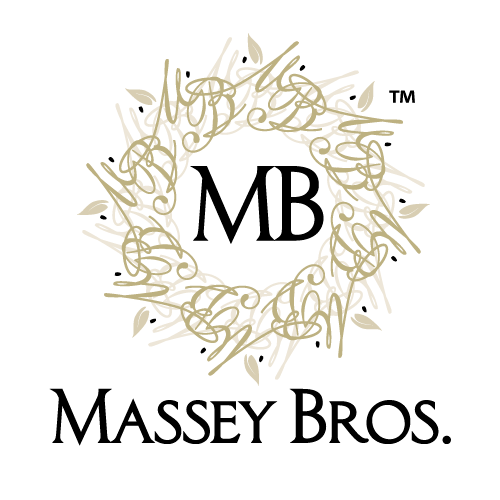
They also have the added complication of having more than six competitors also operating legitimately under the ‘Massey’ name. In addition to this they themselves also operated under two names before their brand refresh! Their brand revitalisation strategy helped them fully leverage their leadership positioning and amplify their multiple new innovative service solutions offered.
Dublin Tourism Board: Refreshes the Destination’s Strategic Positioning
Tourists have a finite number of vacation days and discretionary budget for holidays, so every destination competes to capture that spend. Visit Dublin undertook a study[5] to determine reasons for declining tourism numbers since 2007, resulting in a new positioning crafted to a visitor-focused strategy further analyzed by length of stay, reason for visit, country of origin and more demographics. As a 5-year plan, the realigned strategy, “A Breath of Fresh Air” gets buy-ins from the stakeholders and community to highlight both urban and outdoor visitor experiences.
Old Spice: Rebranded to Reposition – It Used to be on Your Grandfather’s Bathroom Shelf!
Marketing pros everywhere love the transformation of Old Spice[6] fragrance for men from an ageing brand to a sexy one. Aimed at a younger, newly targeted consumer audience, the “Smell Like a Man, Man” campaign (52 million views and counting) smells nothing like 1938, the classic brand’s year of birth.
Learn from these well-known rebranding and brand refresh failures, now text book case studies on approaches to avoid. The primary lesson in each of these examples is do your due diligence before rebranding or refreshing your brand!
Royal Mail:
Consignia was a £2 million investment launched in January 2001 for the U.K. postal service. Calling the new name, “Nine letters that spelled fiasco,”[7] the BBC joined others to prompt a U-turn to return to Royal Mail 16 months later.
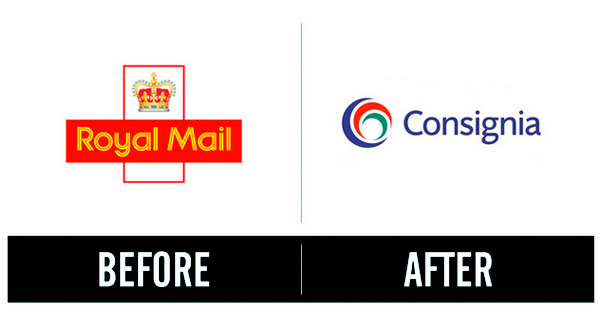
Image via Royalmail
Tropicana:
When parent company PepsiCo removed the leafy green logo and juicy orange pierced with a straw in favor of a one-dimensional glass of juice, Tropicana sales plummeted by 20 percent. On top of whatever the rebrand and reversal cost, sales suffered to the tune of $137 million between January 1st and February 22nd 2009.
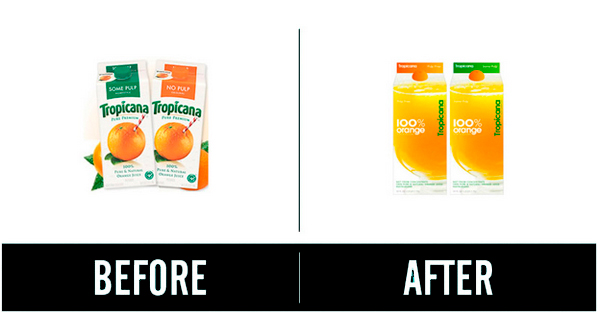
Image via Adage.com
Gap:
Perhaps the fastest rebrand turnaround ever, the new Gap logo lasted only six days at Christmas 2010. Consumer reaction was negative and outspoken. In going back to square one, the whole exercise has been estimated to have cost Gap $100 million.[8]
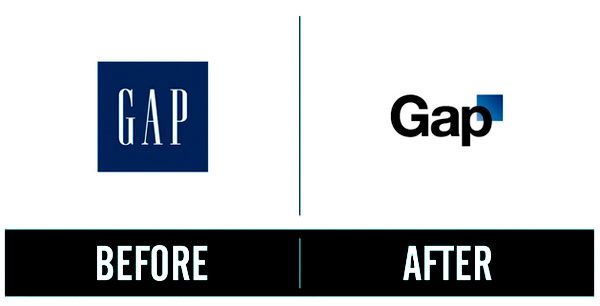
Image via Gap
RadioShack:
RadioShack, founded in 1921, once operated 8,000-plus retail locations around the world. In 2015, after 11 consecutive quarterly losses, RadioShack filed for bankruptcy. Instead of spending millions on a refresh as “The Shack”, the company needed to completely rebrand. Service in RadioShack was reportedly abysmal, selection regarded as limited, prices perceived to be high and the USP as an electronic supplier of parts was no longer considered relevant.
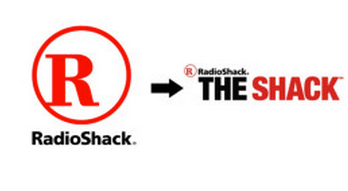
Image via RadioShack
Can we help you with your brand refresh or rebranding?
Ask yourself:
- Are you prepared to undertake a thorough assessment of your brand’s standing by giving your brand a thorough health check — a brand audit?
- Does your brand strategy plan reflect the time commitment involved in making a change?
- Has budget been allocated for a brand refresh or total rebrand?
- Have you identified strategic reasons for a brand refresh or rebranding?
- Is your brand still truly relevant to your target market now and into the future?
- Is your brand really distinctive, different and memorable from a customer/client perspective? Do you need to re-evaluate your brand profile?
- Are you considering a rebrand to solve a brand challenge and / or a commercial challenge?
- Have you really evaluated the impact of new disruptors and challengers entering your market and how your brand will compete against them?
You may also like:
- How Brand Purpose = Purchase = Increased Profitability
- Rebranding Strategy: Why Your Rebrand Must Embrace Storytelling
- Brand Flops: 5 Lessons Brand Managers Can Learn From Epic Brand Failures
- Brand Revitalisation and Relaunch: The do’s and don’ts of doing it successfully!
[1] VIM-Group.com
[2] https://newsroom.accenture.com/subjects/accenture-corporate/andersen-consulting-announces-new-name-accenture-effective-010101.htm
[3] http://content.time.com/time/specials/packages/article/0,28804,1914815_1914808_1914804,00.html
[4] http://www.infinitespada.com/news/what-it-takes-to-rebrand-americas-largest-law-firm
[5] http://www.failteireland.ie/FailteIreland/media/WebsiteStructure/Documents/4_Corporate_Documents/Strategy_Operations_Plans/Destination_Dublin_GDT_2020_Full_File.pdf?ext=.pdf
[6] http://www.personadesign.ie/blog/brand_resurgence_4_lessons_learned_from_amazing_brand_comebacks
[7] http://news.bbc.co.uk/2/hi/business/2002480.stm
[8] https://www.linkedin.com/pulse/million-dollar-branding-mistakes-from-pepsi-radio-shack-quinn?trkSplashRedir=true&forceNoSplash=true
How Do Challenger Brands Become Market Leaders?
/0 Comments/in Brand Culture, Brand Differentiation, Brand Experience, Brand Personality, Brand Strategy, Brand Values, Branding, Challenger Brands, Customer Engagement, Disruptor Brands, Uncategorized /by Lorraine CarterIn Silicon Valley, startups reaching a valuation of $1 billion are known as unicorns because they’re considered so rare. As of April 2016, there are 165 such privately-owned companies from Airbnb to ZocDoc,[1] a number which might suggest to the casual observer that the unicorn isn’t quite so rare after all.
However, “Failure is the norm,” according to Shikhar Ghosh, a senior lecturer at Harvard Business School and expert on entrepreneurship. Among the many millions[2] of global startups annually and within the broader, competitive marketplace, survival — and success — are exceptional.
Great Companies Also Fail
Twenty years ago, another Harvard Business School professor published “The Innovator’s Dilemma” to explore what makes well-managed, top tier companies fail.
Clayton M. Christensen, named the world’s most influential business thinker by Thinkers50 in 2011[3], determined that, “Great companies can fail ― not because they do anything wrong, but because they do everything right. Meeting customers’ current needs leads firms to reject breakthrough innovations ― ’disruptive technologies’ that create the products and opportunities of the future.”
Challenging the Status Quo
A challenger brand attacks the market leader(s) by offering a superior product or service…and by satisfying the customer.
From Silicon Roundabout to Silicon Valley to Silicon Wadi, everyone with a good idea has dreams of becoming the next Gates, Jobs, or Zuckerberg.
Chances are slim indeed for quantity to morph into quality. GEM, the Global Entrepreneurship Monitor, puts the estimate of new companies born each year at 100 million. Of these, half won’t last five years and few will crack through $1 million in yearly billings.[4]
Nevertheless, challenger brands enter vastly different verticals at widely varying moments in the life cycle of that segment’s status quo. Even with a brand new idea, such as online social networking, The Facebook, as it was originally called, was a challenger brand in 2003.
Remember Friendster? Philanthropist Sean Parker, first president of Facebook says of Friendster, “That’s a classic case of where a company just blew it. And MySpace is another case. Facebook had no chance to win; it should not have won the market…the only reason we won was the gross incompetence of MySpace…”
By definition, new contenders are less risk averse, more nimble, and entering their field with lower costs. As Parker points out, established brands must keep a sharply focused view over the shoulder at all times.
However, if a rear view mirror were enough to make it big, we’d see hundreds of thousands of unicorns grazing in virtual startup meadows. Instead, books by hundreds of prize-winning thinkers address and re-address the magic formula for a challenger brand to become a market leader.
Consider how these fundamentals of branding play out on the Challenger Brand Stage.
Five Golden Rules for Challenger Brands
- Differentiate: Define what you’re trying to change — and how
- Influence: Be convinced — and convincing
- Connect: Clearly state your value proposition — authentically
- Communicate: Learn from mistakes — both yours and others
- Innovate: Listen to customers — and keep looking over your shoulder
Are you struggling with how to make your brand highly visible, different, distinctive memorable and loveable? Take a look at the Personality Profile Performer™ Programme. It’s a step-by-step process to make your brand No.1 in your target market — especially if you’re a challenger.
Challenger Brand Case Studies
Natural Foods and Groceries – Whole Foods Versus Everybody
Founded in Austin, Texas in 1980, one small store and four owners decided the natural food industry was ready for a supermarket format. Today, the market leader in organic and natural foods has 440 locations in North America and the UK, with fiscal year 2015 total sales of $15.4 billion, up 8 percent year-on-year. Over 5 percent of total net profits goes to charities.

Image via www.wholefoodsmarket.com
Whole Foods is no stranger to connecting with customers and other branding fundamentals. Their fourth quarter earnings report states, “There has never been a time where customers have had more interest in what they eat, where it comes from and who’s growing it. Our company mission, commitment to transparency, and culture of innovation are more relevant than ever, and we see tremendous growth potential as food consciousness continues to evolve.”
How focused is Whole Foods on looking over their shoulder? “We recognize the need to move faster and go deeper to rebuild traffic and sales and create a solid foundation for long-term profitable growth and are taking the necessary steps to better communicate our differentiation, improve our value perception, and fundamentally evolve our business.”
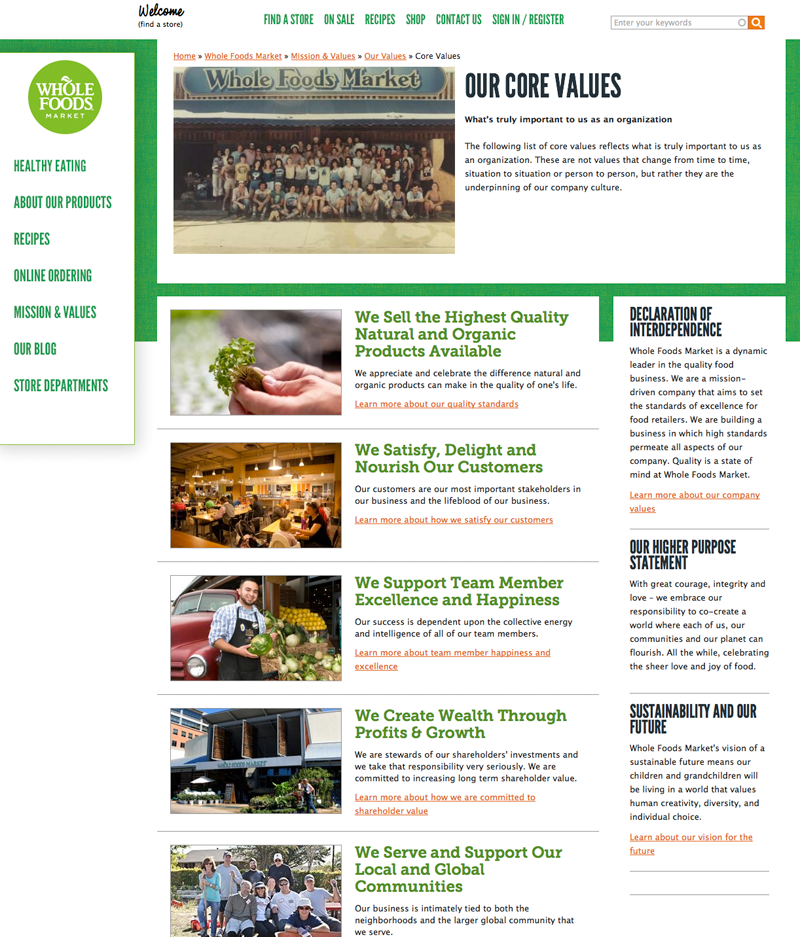
Image via www.wholefoodsmarket.com
Team Communications – Slack Versus Email
Have you ever heard anyone say how much they absolutely love email? It just doesn’t happen. Yet, customers are passionate about Slack.

Image via www.slack.com
“I love Slack. I really, really do. So much so I would call it an addiction at this point,” wrote Dave Teare, founder of Canadian-based 1Password, the secure password app that started as a two person company 10 years ago and grew to over 60 people. Using Slack as the internal communications channel, Teare says, “As a company we’ve never felt more connected. The notifications are to die for. They are simply amazing and fun to receive.”
The cloud-based software developed in summer 2013 is meant to reduce or eliminate workplace email. About 8,000 customers signed up within 24 hours of launch and in 2015, Slack passed one million daily active users. The Financial Times wrote that Slack was the first business technology to cross from business to personal use since Microsoft Office and the BlackBerry.
Several months ago, the free messaging app lit up the tech press when it raised funds at a $1.2 billion valuation. Well, try $2.8 billion now, and still growing.
“Better than truffles,” and “in love with a service” are the kind of comments you’ll find when you visit the Wall of Love to find out what happy customers are saying. Take the tour. Slack clearly states the value proposition, “A new kind of messaging…what’s different about Slack…and no more email.”
On-demand Transportation – Lyft Versus Uber
Ride-sharing conducted on smartphones has shaken up the taxi and limousine business in urban centers all over the world. Passengers request a ride on a mobile app and get connected to a nearby driver, displaying profile, name, headshot, vehicle make and model of their car, and estimated arrival time. No payment transaction is needed, as payments are automated.
In some cities, competing brands exist in the massive transportation industry. Uber and Lyft are chief among these. Uber has spread to 58 countries, Lyft is available in 200+ US cities.
Despite being the challenger brand, Lyft expected to reach $1 billion in gross annual revenue in 2015, up from $130 million, the company’s co-founder told Reuters. Uber’s gross bookings were projected to hit $10.84 billion in 2015, rising to $26.12 billion in 2016.[5]

Image via www.rideshare.com
Each service offers a different ride experience, including casual, shared, disabled, limousine. All offer a deeply personal solution to a problem: getting from A to B affordably, safely, reliably and on-demand.
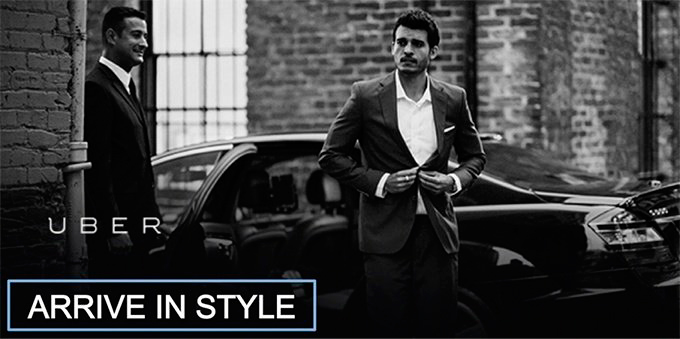
Image via www.rideshare.com
Uber started as a luxury car service with the motto, “everyone’s private driver,” and they take a higher percentage from the drivers, too. In a Lyft car, passengers fisty-bump (it’s an insider gesture) with the driver and sit in the front seat. The touchy-feely brand has the motto, “your friend with a car.”

Image via www.rideshare.com
The ramifications of the taxi and limousine disrupt are potentially far-reaching. Observers are watching to see whether the post-IPO Uber Technologies Inc. [UBER.UL] and privately-owned Lyft carve out different strategic areas within each brand. For Lyft, possibly impacting commuter habits across America[6] and for Uber, competing with Google to upset the entire automobile industry with driverless cars.
Men’s Shaving – Dollar Shave Club Versus Gillette
Since the dawn of the 20th century, shaving for gentlemen has been dominated by the safety razor from Procter & Gamble’s Gillette, a brand valued at $20.5 billion, accounting for 70 percent of the global market.
Yet, the in-store shopping experience is not entirely customer friendly with packaging which can be somewhat challenging for the less nimble fingered and complicated blade choices, all of which are typically locked behind glass cases due to their higher prices.
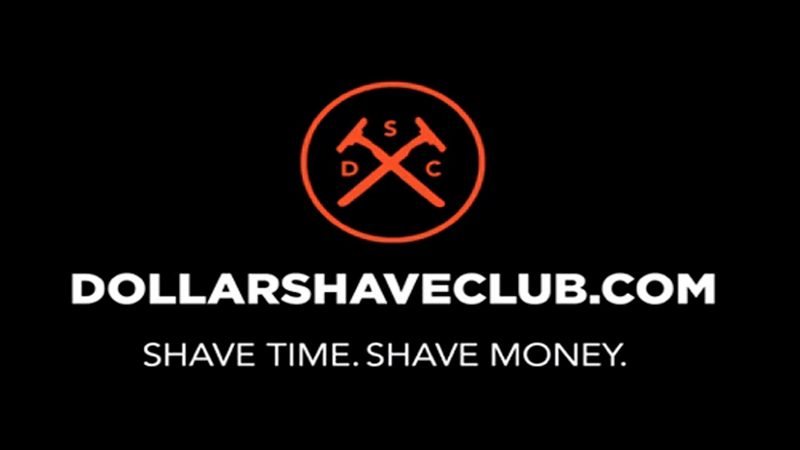
Image via www.dollarshaveclub.com
Dollar Shave Club focused on that reportedly unappealing customer experience, encouraging consumers to join a home delivery scheme to “Shave Time. Shave Money.” The Guardian reports that “Dollar Shave Club’s sales have steadily increased since its launch, from $4m in 2012 to a projection of between $140m and $150m this year, with 2.4 million users.”
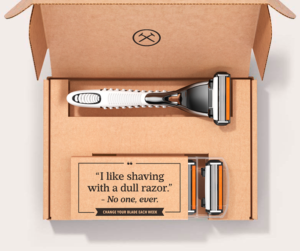
Image via www.dollarshaveclub.com
Watch Michael Durbin, the Venice, Californian-based former improv comic present his vision in a YouTube video that prompted 12,000 orders in a two-day span after it was released in 2012 and has now enjoyed 22 million views.
- Which of these challenger brand case studies do you find most compelling and why?
- Can you think of an industry that’s a prime target for a challenger brand?
- Do you agree that building a sound brand strategy begins with research: knowing what customers need — not what you think they need?
- As a challenger brand, can you carve out a very unique niche to own and defend?
- Do you know how to make your message totally unique, memorable and relevant to your target audience?
- In what ways do you think a challenger brand should market itself differently from market leaders with larger resources?
You may also like:
• The Power of Disruptor and Challenger Brands
• The Profit Power of Cult Brands, Why and How to Create One
• Brand Profiling: How Brand Performance and Purpose are Inextricably Linked
• Rebranding Strategy: Why Your Rebrand Must Embrace Storytelling
• Brand Profiling: How to Use Emotion to Make Your Brand More Profitable
• Brand Revitalisation and Relaunch: The do’s and don’ts of doing it successfully!
• Brand CSR: The Business Case for Successful Branding and Social Good

[1] http://techcrunch.com/unicorn-leaderboard
[2] Gem-2015-2016-global-report-110416-1460370041.pdf
[3] http://thinkers50.com/t50-awards/awards-2011
[4] https://www.allbusiness.com/million-dollar-startup-secrets-16694845-1.html
[5] http://www.reuters.com/article/us-lyft-runrate-exclusive-idUSKCN0T621K20151117#7j71Oao6sDUYoY7r.99
[6] http://www.nytimes.com/2014/08/07/technology/personaltech/lyft-tries-to-coax-commuters-to-leave-their-cars.html
Brand Equity: How to Measure the Strength and Effectiveness of Your Brand
/0 Comments/in Brand Audit, Brand Auditing, Brand Audits, Brand Culture, Brand Loyalty, Brand Personality, Brand Profiling & Positioning, Brand Promise, Brand Relevance, Brand Research, Brand Values, Brand Voice, Branding, Business /by Lorraine CarterAccording to statistics, 88 percent of consumers say quality makes them loyal to a brand, and only 50 percent say price is their primary concern. [1] Also, when people have a negative experience with a brand, 50 percent said they were unlikely to consume content from that brand again. Clearly, this data shows how important it is to ensure your brand is sending the right messages to your customers, and making them want to align with it for the right reasons.

Image via www.business2community.com
What is a Brand, and Why is Brand Equity So Important?
Your brand encompasses your total offering to your customers,[2] from what it stands for, to its personality, the experience it gives your customers, what it promises to deliver consistently, the language, tone of voice and messaging it uses to express itself throughout its communications, the fundamental culture of the organization it represents, its brand collateral and the people who represent it.
In short it’s the sum of all its parts from the quality of its offering to its attributes and the emotional meanings associated to it together with all its brand collateral which includes visual identifiers like its logo, website, packaging, printed literature, trade stands, staff uniforms, interior and exteriors site design and signage, vehicle livery, video content and so forth. All of these elements collectively are what make up your brand when they all consistently and congruently engage your primary audience in a way which is relevant to them, yet are distinctive, different and memorable.
Brand equity is then derived from the overall perception of your brand, the way customers perceive your total brand offering, products or services, rather than the just the isolated features and benefits of the offerings themselves. When customers have a favorable brand perception with a consistently good experience, it’s far more likely they’ll remain loyal to your brand, and recommend it to others. In order to achieve strong brand equity, your brand needs to be unforgettable to your customers — it must resonate both with their hearts and their minds.
However, strong brand equity has more advantages than just customer loyalty: [3]
- It enables you to form stronger ongoing relationships and negotiating power with vendors
- Positive brand equity supports long-term company growth e.g. expansion into new markets, product extensions etc.
- Strong brand equity could partially shield you if you hit a bump in the road e.g. reputational ramifications related to something unusual such as defective product or atypical manufacturing delay — assuming you handle the situation appropriately
- Fundamentally customers are willing to pay more for a brand they trust and value
Although brand equity may seem intangible, it has real dollar, euro, or pound value. Brand equity can be tracked and measured using a combination of specialist research and specific algorithms applied on a comparative annual basis.
Measuring brand equity accurately is a niche expertise, with a number of companies specializing in this particular field. Interbrand is one of those companies and they annually track the brand equity value of companies and brands from year to year. By way of example, in 2014 the brand equity of credit card company American Express was $19.5 billion. That figure is impressive in itself, but it’s even more striking to note the brand’s equity value had grown 11 percent from the previous year. [4]
Evaluating Your Brand Equity: Auditing its Current State and Identifying Weaknesses
The first step in analyzing your brand equity is to get a reading of customer perceptions. It’s also important to research employee perceptions for comparative alignment. If there are underlying problems with a company’s brand culture there are also likely to be underperformance issues coupled with incongruent communications that customers will pick up on — all of which means they will be less likely to embrace your brand, and may even doubt its authenticity, which in turn causes a lack of trust.
A brand audit health check is a very useful and practical way to gauge how your primary audience and staff feel about your brand. It can also enable you to identify weaknesses that might not have been noticed previously. Once you identify weaknesses and inconsistencies in your brand, you’ll be in a much better position to convert them into strengths, or at least minimize the aspects of those weaknesses that make your brand less effective when pitched against your competitors. A brand audit health check also enables you to uncover and identify new opportunities for growth and innovation.
Make Your Brand Stronger using Keller’s Brand Equity Principles
When working with our clients to help them develop stronger brand equity, we also advocate principals from Keller’s Brand Equity Model, also known as the Customer-Based Brand Equity (CBBE) Model. It suggests before you’re able to strengthen brand equity, you must first shape how customers think and feel about the brand. [5]
The model is a pyramid shape, with brand identity at the bottom. That section represents the key characteristics and personality of the brand. It’s important customers recognize those attributes correctly, and believe they are different from what competitors offer.
The next level of the pyramid relates to brand meaning. In other words, what does your brand stand for, and how well does it meet customers’ needs, both in terms of performance, and on social and psychological levels? Think about the ways you want customers to experience your brand, and use those factors to create your brand personality and key characteristics.
Brand response represents the third tier of the pyramid. Credibility, actual and perceived quality, and comparisons with competing products all help shape brand response. Your goal is to make your brand evoke direct feelings and innate emotions.
The top level of the pyramid is brand resonance. When customers actively engage with your brand even when not purchasing it, that demonstrates brand resonance, as does a desire to be associated with a “community” of fellow purchasers. Customers also show brand resonance through behavioral loyalty, such as repeat purchases.
Measuring Brand Equity with the Six-Stage Brand Development Model
The six-stage brand development model is a diagnostic tool that combines proven metrics and a framework to guide brand equity strategies. Below, you’ll find the different characteristics a brand should have [6], plus how to make improvements if necessary.
- A Brand Should Be Recognizable: If your brand lacks recognition in the marketplace it’s crucial to develop your brand strategy and enaction it tactically with a fully intergrated branding plan in order to raise its profile. Brand recognition increases through repeated exposure.
- The Brand Must Be Memorable: The brand should be among the first called to mind when customers decide what to purchase. If that’s not happening, educate your target market about what your brand offers and why it’s unique – while remembering to enage your aduience at both emotional and rational levels.
- A Brand Should Be Viewed Favourably: As we often remind our clients, it’s not enough for people to be aware of a brand. The target audience must also believe the brand is able to meet their needs with trust and respect for what the brand represents.
- A Brand Should Be Distinctive: When customers are ready to buy an item (product or service), they must feel compelled to do so because they think the product offers a unique brand promise unlike what any competitors can provide. Brand perception occurs at both functional and emotional levels, so the goal is to position your brand effectively by stressing attributes that motivate purchases.
- The Brand Must Be Preferred: Ideally, customers will prefer your brand over all others, and be willing to purchase it repeatedly. If preference for your brand is low, you’ll need to evaluate why through a brand audit and then implement changes based on the analysis and findings made. Fundamentally you must build brand trust if you want to engender long term brand loyalty.
- Your Market Must Be Satisfied with the Brand: Ideally, customers will be so happy with what your brand offers they aren’t just personally content, but eager to recommend your brand to friends — become brand champions. If that isn’t currently happening, you may need to evaluate where the discontent lies and work on improving your product or service in terms of both percieved and actual quality.

Image via www.mindtools.com
Let’s briefly examine three case studies where improving brand equity was the central goal:

Image via www.starbucks.com
Starbucks
Starbucks has become a global brand worth $10 billion. In 2011, the brand went through a brand identity expansion to boost brand equity. A recognizable green mermaid traditionally decorated bags of the brand’s trademark coffees.
However, Starbucks wanted to expand its future vision by also using its identity more broadly on other products besides coffee, and associate it with offerings like teas and lemonades. The transition to use the mermaid logo more broadly was lauded by industry experts [7], with some believing strongly the broader use of the logo would trigger new growth and bolster recognition, without compromising acquired brand equity.

Image via www.veritaswines.com
Veritas Winery
Established in 2002 as a family-run business, Veritas Wineries was one of the first businesses of its kind in Virginia. The company realized its history and provenance helped establish its brand equity and wanted to implement some brand enhancements without compromising its valuable legacy.
The company commissioned a full brand audit, which resulted in small but meaningful changes [8] to the brand’s identity and made the overall brand more consistent to promote prolonged marketplace success. These alterations have enabled the brand to maintain its dominance, despite increasing competition.
Coca-Cola
Coca-Cola used “Open Happiness,” as a global campaign, to appeal to its consumers’ desire to feel optimistic and be comforted despite a weak economy. At the time, it was the brand’s first new campaign in three years. Advertising spots ran in both print and television media.
Although previous campaigns won awards, some analysts felt they required localized tweaking to resonate with culturally different audiences in different parts of the world. [9] The intention was that “Open Happiness” would have mass worldwide appeal. In the end, that goal was achieved, and the campaign achieved widespread industry praise for its ingenuity.
In conclusion, brand equity is measured one brilliant customer experience at a time. That’s why it’s so important to maintain a positive brand tone, understand how to relate to your target audience in a way that matters most to them, while simultaneously meeting their needs. Building and maintaining brand equity is an ongoing process, remember successful brand building is as much about all the small things you do consistently well coupled with the bigger campaigns and new initiatives.
Key Takeaways:
- Brand equity can make the difference in how customers experience your brand, and whether they want to align themselves with it.
- Brand equity is derived from customer perceptions. Strong brand equity increases the likelihood customers recommend your brand to others.
- A brand audit can indicate how customers perceive your brand, and enable you to identify weaknesses.
- Brand equity is tied to how customers both think and feel.
- Brands should be preferred, distinctive, favorably viewed, recognizable and memorable if strong brand equity is to be achieved.
Questions to consider:
- What actions or brand strategies could be implemented to increase customer engagement with your brand?
- What would help improve the actual and perceived quality of your brand?
- Have you taken steps to become informed and evaluate your brand’s weaknesses compared to competitors?
- Do you feel your brand adequately conveys why and how it meets your customer needs?
- Does your brand connect with people globally, and is that necessary for its brand equity?
You might also like:
• Brand Personality: Is Your Brand’s Character Big Enough to Compete?
• Rebranding Strategy: Why Your Rebrand Must Embrace Storytelling
• Brand Loyalty: 5 Key Steps to Building Your Loyal Fan Base
• Brand Audit: Tips for Determining Your Brand’s Health – Can It Be Improved?
• Humanizing Your Brand: Why It is Key to Commercial Success
• Brand Differentiation: 30 Ways to Differentiate Your Brand
• Brand Profiling: Top 6 Components to Creating a Strong Brand Personality
• Creating New Brands: Top 10 Tips for Brand Success
• Brand Profiling: How to Use Emotion to Make Your Brand More Profitable
[1] Eric Hammis, http://www.business2community.com, “How Important is Brand Identity?”, April 2015.
[2] Lois Geller, http://www.forbes.com, “Why a Brand Matters”, May 2012
[3] John Fatteross, http://www.thehartford.com, ” Advantages of Strong Brand Equity”
[4] Jennifer Connelly, htttp://www.entrepreneur.com, “‘Brand Equity’ is an Intangible That’s Worth Real Money”
[5] https://www.mindtools.com/, “Keller’s Brand Equity Model: Building a Powerful Brand”
[6] http://rockresearch.com/a-brand-development-model-how-to-define-and-measure-brand-equity/, “A Brand Development Model: How to Define and Measure Brand Equality,” December 2013
[7] Carl Johnson, http://www.adage.com, “Why Starbucks Logo Change Doesn’t Equate to Brand Change,” January 2011
[8] http://www.designbywatermark, “What is a Brand Refresh?”
[9] Betsy McKay and Suzanne Vranica, http://www.wsj.com, “Coca-Cola to Uncap ‘Open Happiness’ Campaign” January 2009
About
Persona Branding & Design Consultants
Contact: Lorraine Carter
T: +353 1 832 2724
Carra House
Howth, Co. Dublin, Ireland
Copyright © 2007-2022 All rights reserved.
Persona Design Consultants Ltd.
Registered in Ireland: No. 201997
Member of


